#the first passage i posted was from the very first story and this one is from the 2nd last one btw
Explore tagged Tumblr posts
Text
brain said "analysis time", this got long, sorry in advance.
tl;dr 4-6 years passing probably does work but serpentine ages and aging rates make my head hurt and i'm probably more in the 3-4 years passing club anyway (but probably at least a year going by between Crystallized and The Merge in the first place)
See I definitely think it's been at least 3 years thanks to Crossroads Carnival. The put up the tent to honor the ninja "every year" which implies two years at minimum, but "every year" feels more like an implication of this being the 3rd+ time it's happened. It could easily be somewhere in the 4-6 range based on that too, and it's definitely been a few years thanks to Sora, Arin, and Wyldfyre all going from short to long legs, but there's just one little problem that sticks out to me.
Spitz.
Cole: Yeah. I had no clue where I was. The Finders took me in. Sora: The Finders? (Fritz and Spitz pop up behind Sora.) Fritz: He means us! I'm Fritz. Spitz: Ssspitz here! You lose it, we find it. Hence, the Finders.
~~
Nya: So, if your theory about this place is right, then those kids are also lost? Forgotten? Cole: Yep. Each of them ended up here after running away from home.
To me, the dialogue implies that Fritz and Spitz were there before Cole was. It could just be saying the Finders as a group name were there before Cole was, which would imply at least two of the others were there before him (thus it could have just been Geo and Bonzle before Cole was there). Still, the phrasing seems to be implying Cole is the most recent addition to the Land of Lost Things. It wouldn't be that much of a problem chronologically...
...if it weren't for Skales Junior, Season 9, and (to some extent) Tommy Andreasen.
Even if we DO choose to ignore Andreasen's statements about the S3->S4 timeskip being longer than the S2->S3 timeskip (more specifically that the S3->S4 timeskip was the longest as of August 2016, post-Skybound and pre-DotD) and the statement about Junior having been born in the new village and not the tombs (February 2017), Skales's dialogue in "The Curse of the Golden Master" seems to imply that Junior was born/hatched more recently anyway.
Kai: Skales Jr.? Uh, you have a son? Skales: We've been busy since you left us. And we prefer to keep it that way.
Which not only begs the question of how much time passed between seasons, but also the question of how quickly Serpentine mature (and how old you thought Junior was in equivalent human years). Depending on your answer for the first question, the answer to the second changes.
And for a time, it was easy enough to say maybe a few years passed between S2 and S3 (I don't know what the general consensus is/was but I tended to say 2-3 years), and Serpentine matured somewhere from 2-4 (or maybe more) times faster than humans. Junior didn't change much in his Tournament of Elements appearance (assuming it wasn't just a chance to reuse a model instead of creating a new one(which it totally was)), so things seemed easy. Hands of Time also didn't see a model change, but the amount of time that passed from S4 to S7 is a bit up in the air anyway. What mattered was he was still a kid and there wasn't gonna be a need to change the model that wasn't gonna be on screen for more than 5 minutes.
And then a year went by in Ninjago to reach Season 8, and a week after the Bounty is destroyed we pick up in Season 9. And Season 9 has "The Gilded Path" and the following exchange.
Kai: Jay, we're still teenagers. Jay: Yeah, but grown-up teenagers.
I know it's probably supposed to be tongue-in-cheek and leaning on the fourth wall more than a statement to take seriously, but the fact of the matter still stands that Kai and Jay are "grown-up teenagers", with the implication being that Cole is one as well. The diction/cadence Jay uses doesn't necessarily imply that they have to be 18 or 19, but I'd only put them at 17 at the youngest here. (Zane is a robot and can't help us in this situation. Sorry buddy)
Assuming they're 19 as of Season 9, that means the trio was 18 in Season 7 (with the possibility of Jay being either almost 18 or almost 19 thanks to the early birthday present stuff). Seeing as all three of them have full-length minifigure legs during their Wu Recruitment in the pilot (and the expanded S8/S9 versions for Cole and Jay), then presumably they're at least teenagers at that point. (I recognize that the mid-length legs weren't a thing at this point, so theoretically there could be more nuance to their ages, but I have at least a little faith that Wu wouldn't purposefully seek out and recruit Actual Children.) Going on the furthest bounds, that would make the trio 13 (or maybe 14) in the pilots, leaving 4 or 5 years for all the events from the end of the pilots to the start of Season 7. It's certainly possible to have everything happen in that span of time depending on how much time you allot to each season's events and the passage of time between them, but it can get kind of tight. Plus it means Nya is kinda young during the pilots which is just so weird to think about.
But then Skales Junior makes things weird again, and in turn makes things weird for Spitz. Junior can't grow up at the same rate a human does, but he also can't grow up too fast.
Maybe it's just me, but it would feel strange for rapid aging to only get a snake to a young child stage and not a teenager or even a preteen stage. However, this does not seem to be the case with Skales Junior, and it would be logical to avoid the same to Spitz seeing as they're both Hypnobrai (or at the very least Spitz is a Hypnobrai hybrid and that phenotype shows prominently compared to someone like Clancee).
And it's not exactly easy to say that in a year (or less) Junior went from being born to being the human equivalent of something like a 10 year old, because by consensus Spitz would then be a young teenager and that really doesn't seem to be the case (unless the snake is just short, in which I feel your pain Spitz, people mistake you as being younger than you are). I sincerely doubt Spitz is supposed to be equivalent to a human somewhere from 14-16 years old. Even assuming Spitz only wound up in the Land of Lost Things fairly early in life (~3-5 human years, maybe?) then the snake would still wind up as a young teen.
In theory, the Serpentine could speed through the early development stages and a snake around one year old could be roughly equivalent to a young child. Possibly 6-8ish, but I have no idea how old Junior is supposed to be in S3. (I've seen some guess he's closer to 4 or 5, but he could also very well have been almost 10.) He definitely feels on the younger side there and older in S7, but he still has short legs and is probably equivalent to a 10 or 11 year old at MOST. Maybe after the initial spike, they level out and might only be a little faster than humans if there's a difference in the first place.
In a case like that, Spitz probably wouldn't be an issue. Assuming the little snake was about a year old when arriving in the Land of Lost Things (with The Merge happening shortly after arrival) and it's been 4-6 years since then, it's entirely possible for Spitz to have been equivalent to a 6 year old human upon arrival and is somewhere from 10-12 now, which would make short legs appropriate. (In theory the medium legs might also work, but the range of ages that use those legs is a bit up in the air.) Spitz could have also wound up there less than a year before The Merge and would be even younger, but that's also assuming my Serpentine-to-human age equivalence estimate is correct. Spitz also might very well have ended up in the Last of Lost Things longer before the Merge, maybe having lived there for a year before everything went sideways. We don't know.
There's also every possibility that Serpentine might only "spike" to the equivalent of a human 4 or 5 year old after a year. If not much time passed from the end of Spitz's "spike" and arrival in the Land of Lost Things and the Merge then it's entirely possible for the little snake to only be a human 8-11 now. But by that same logic, Spitz could again have wound up lost earlier
Keep in mind this is also actively ignoring creator statements and only considering in-show dialogue. If Andreasen's word about early timeskips is considered, then there's either even less time for Junior to grow up or there's not a lot of time between other seasons or for them to happen to begin with. There's also the statement from the Hagemans of how the ninja are supposed to be "eternal teenagers"(September 2017) and Andreasen's tweet how the ninja have "no specific ages"(December 2017). Granted, these were both tweets sent before the line in Season 9, but there's a difference between "the creators say they're supposed to be teenagers" and "characters in the show confirm they are teenagers".
And none of this is helped by Andreasen's other statements on the timeline.
[The rest of this is just me getting annoyed at the timeline but I do think it's important context as to why I have the thoughts I do about the merge timeskip. I shit you not I have a whiteboard in my room that was dedicated to me trying to figure out the timeline post-Seabound and a sequel in the form of an MSPaint file. I love this series but I would kill for whatever timeline the writers used as reference. if they even had one.]
[edit: I talked to a friend about this and another completely viable option is a spike into toddler age and then long/slow childhood.]
On September 23rd, 2016, he stated that Zane's new body was "2 years old max" and that Pixal was "No[sic] old … 3-4 years?" and built "Between season 2 and 3". Considering these statements were made in the window after Skybound had aired but before the official/"main" teaser for Day of the Departed (and obviously in turn before the special aired), it's hard to know exactly which point should be used as reference for these timeframes. I'm leaning more towards DotD, partially due to knowing (more or less) how much time passes from there on. 2 years from the end of Rebooted to DotD and then a day or two to reach S7. Season happens and from there it's a year to S8, and with a bit more time beyond that we reach S9 and the accursed teenagers line.
Pixal helps out by narrowing time down to 1-2 years passing from her build date to the end of S3, and some of that time can be take up by the creation of Zane's statue. There's… still kind of the problem of alloting how much time actually goes by, seeing as S3->S4 still has to be greater than S2->S3, but if it's a year from Pixal to 34 credits, then it could theoretically be less than a year from S2->S3 in general.
You know, if it weren't for Borg Tower. That is a 100-story skyscraper. Those take time to build. Even the Empire State Building took more than a year from construction start to finish (and had a bit less than a year of planning ahead of time, as far as I can tell), but most take longer than that. So that means roughly a year should go by from S2->S3, and then a bit more time than that passes in the season itself. Which means over a year goes by from S3->S4 and that leaves only a year maximum for start!S4->DotD to happen which is possible (and does slot well enough together with the limited amount of time ghosts are able to exist in Ninjago before fading)…
…unless the New Year and Day of the Departed happen to be at similar times to when they are in real life. Seeing as Day of the Departed is "inspired by holidays all over the world", but does heavily draw from Halloween and Día de Los Muertos (with elements of the Japanese Obon/Bon festival and the Chinese Ghost Festival), it's more likely to be later in the year than earlier. (The wiki also says there are elements of Memorial Day, but that's more for military personnel instead of the general public, y'know?) Seeing as we don't know what the months are in the Ninjago world, I'm just gonna use the real-world ones for reference for a moment. The New Year could very well be the first day of January, or it could be variable in some day from January to February like the Chinese New Year.
While there are other New Year dates used by various real-world religions and cultures, I… sincerely doubt the Ninjago writers took them into consideration. And while there certainly is influence from Obon and the Ghost Festival on Day of the Departed, the show is kinda meant for an audience more familiar with Halloween and Día de Los Muertos. To the point where the special was initially aired in October to line up with those holidays (as opposed to airing in August, to line up with Obon and the Ghost Festival). This only creates problems because of Cole, and how "ghosts cannot remain in Ninjago for long without a vessel." We don't know how long "for long" could be, but I'd say nearly a year is more on the long side. Day of the Departed COULD be sooner into the year for all we know, but no matter what there's still the matter of having S4, S4->S5, and the majority of Season 5 also all happen alongside the S5->DotD skip in a year or less.
Part of my issues with the timeline might just stem from having read "A Team Divided" and the real-world passage of time between S2 and S3. That timeskip always felt longer to me than S3 to S4. There needs to be time to build a skyscraper and for Darkley's to become Wu's Academy. There needs to be time for the city to change. There needs to be time for Skales Junior to hatch and grow up at least a little bit. There needs to be time for Pixal to be designed and finished. There needs to be time for everything to happen. It can't be "not that long really" between S2 and S3 and then have it be longer between S3 and S4. I know Jay needs time to host his show and for Zane to be able to back up all 74 episodes (and holiday special) if Decoded is taken as canon, and I know that line is a nod to the length of the series at the time, but it's still something said and I can't just pretend it doesn't exist.
There needs to be time for Ninjago to happen and sometimes it feels like the series doesn't have enough of it.
#ninjago#spitz ninjago#skales jr ninjago#was gonna keep this in the tags but figured it'd be easier to explain in a proper post#very glad i decided to make it an actual post instead of trying to fit all these thoughts in the tags#this took over 6 hours to write up and get all the information and double-check everything @~@#yes part of this was also an excuse to complain about the passage of time#also i recognize the tweet glen lakin made about fritz and spitz's names but i want to stick with in-show stuff first and foremost#and frankly it doesn't actually help that much considering one of them is a formling and the other is a serpentine#(if old statements are to be believed then formlings age at a different rate so who knows how old fritz might be)#(but there's also the newer statement from doc wyatt of time passing differently in the never-realm which makes things weirder)#look in know in the grand scheme of things a year might not be that long really but in the scope of present-day ninjago? that's a long time#and i refuse to have it be less than a year because while there might be some skyscrapers that CAN go up in a matter of weeks nowadays#they also aren't 100-odd stories high and an entire factory built into them (if not multiple factory lines)#at this point i'm really out here like ''i can excuse the contrived love triangle but i draw the line at unrealistic building timelines''#long post#side note is there a consensus on spitz's pronouns or have we all just agreed to sidestep the issue for now#(considering the circumstances i... don't know if spitz really knows either)
106 notes
·
View notes
Text
Canada’s ground-breaking, hamstrung repair and interop laws

If you'd like an essay-formatted version of this post to read or share, here's a link to it on pluralistic.net, my surveillance-free, ad-free, tracker-free blog:
https://pluralistic.net/2024/11/15/radical-extremists/#sex-pest

When the GOP trifecta assumes power in just a few months, they will pass laws, and those laws will be terrible, and they will cast long, long shadows.
This is the story of how another far-right conservative government used its bulletproof majority to pass a wildly unpopular law that continues to stymie progress to this day. It's the story of Canada's Harper Conservative government, and two of its key ministers: Tony Clement and James Moore.
Starting in 1998, the US Trade Rep embarked on a long campaign to force every country in the world to enact a new kind of IP law: an "anticircumvention" law that would criminalize the production and use of tools that allowed people to use their own property in ways that the manufacturer disliked.
This first entered the US statute books with the 1998 passage of the Digital Millennium Copyright Act (DMCA), whose Section 1201 established a new felony for circumventing an "access control." Crucially, DMCA 1201's prohibition on circumvention did not confine itself to protecting copyright.
Circumventing an access control is a felony, even if you never violate copyright law. For example, if you circumvent the access control on your own printer to disable the processes that check to make sure you're using an official HP cartridge, HP can come after you.
You haven't violated any copyright, but the ink-checking code is a copyrighted work, and you had to circumvent a block in order to reach it. Thus, if I provide you a tool to escape HP's ink racket, I commit a felony with penalties of five years in prison and a $500k fine, for a first offense. So it is that HP ink costs more per ounce than the semen of a Kentucky Derby-winning stallion.
This was clearly a bad idea in 1998, though it wasn't clear how bad an idea it was at the time. In 1998, chips were expensive and underpowered. By 2010, a chip that cost less than a dollar could easily implement a DMCA-triggering access control, and manufacturers of all kinds were adding superfluous chips to everything from engine parts to smart lightbulbs whose sole purpose was to transform modification into felonies. This is what Jay Freeman calls "felony contempt of business-model."
So when the Harper government set out to import US-style anticircumvention law to Canada, Canadians were furious. A consultation on the proposal received 6,138 responses opposing the law, and 54 in support:
https://www.michaelgeist.ca/2010/04/copycon-final-numbers/
And yet, James Moore and Tony Clement pressed on. When asked how they could advance such an unpopular bill, opposed by experts and the general public alike, Moore told the International Chamber of Commerce that every objector who responded to his consultation was a "radical extremist" with a "babyish" approach to copyright:
https://www.cbc.ca/news/science/copyright-debate-turns-ugly-1.898216
As is so often the case, history vindicated the babyish radical extremists. The DMCA actually has an official way to keep score on this one. Every three years, the US Copyright Office invites public submissions for exemptions to DMCA 1201, creating a detailed, evidence-backed record of all the legitimate activities that anticircumvention law interferes with.
Unfortunately, "a record" is all we get out of this proceeding. Even though the Copyright Office is allowed to grant "exemptions," these don't mean what you think they mean. The statute is very clear on this: the US Copyright Office is required to grant exemptions for the act of circumvention, but is forbidden from granting exemptions for tools needed to carry out these acts.
This is headspinningly and deliberately obscure, but there's one anecdote from my long crusade against this stupid law that lays it bare. As I mentioned, the US Trade Rep has made the passage of DMCA-like laws in other countries a top priority since the Clinton years. In 2001, the EU adopted the EU Copyright Directive, whose Article 6 copy-pastes the provisions of DMCA 1201.
In 2003, I found myself in Oslo, debating the minister who'd just completed Norway's EUCD implementation. The minister was very proud of his law, boasting that he'd researched the flaws in other countries' anticircumvention laws and addressed them in Norway's law. For example, Norway's law explicitly allowed blind people to bypass access controls on ebooks in order to feed them into text-to-speech engines, Braille printers and other accessibility tools.
I knew where this was going. I asked the minister how this would work in practice. Could someone sell a blind person a tool to break the DRM on their ebooks? Of course not, that's totally illegal. Could a nonprofit blind rights group make such a tool and give it away to blind people? No, that's illegal too. What about hobbyists, could they make the tool for their blind friends? No, not that either.
OK, so how do blind people exercise their right to bypass access controls on ebooks they own so they can actually read them?
Here's how. Each blind person, all by themself, is expected to decompile and reverse-engineer Adobe Reader, locate a vulnerability in the code and write a new program that exploits that vulnerability to extract their ebooks. While blind people are individually empowered to undertake this otherwise prohibited activity, they must do so on their own: they can't share notes with one another on the process. They certainly can't give each other the circumvention program they write in this way:
https://pluralistic.net/2024/10/28/mcbroken/#my-milkshake-brings-all-the-lawyers-to-the-yard
That's what a use-only exemption is: the right to individually put a locked down device up on your own workbench, and, laboring in perfect secrecy, figure out how it works and then defeat the locks that stop you from changing those workings so they benefit you instead of the manufacturer. Without a "tools" exemption, a use exemption is basically a decorative ornament.
So the many use exemptions that the US Copyright Office has granted since 1998 really amount to nothing more than a list of defects in the DMCA that the Copyright Office has painstaking verified but is powerless to fix. We could probably save everyone a lot of time by scrapping the triennial exemptions process and replacing it with an permanent sign over the doors of the Library of Congress reading "Abandon hope, all ye who enter here."
All of this was well understood by 2010, when Moore and Clement were working on the Canadian version of the DMCA. All of this was explained in eye-watering detail to Moore and Clement, but was roundly ignored. I even had a go at it, publicly picking a fight with Moore on Twitter:
https://web.archive.org/web/20130407101911if_/http://eaves.ca/wp-content/uploads/2010/Conversations%20between%20@doctorow%20and%[email protected]
Moore and Clement rammed their proposal through in the next session of Parliament, passing it as Bill C-11 in 2012:
https://en.wikipedia.org/wiki/Copyright_Modernization_Act
This was something of a grand finale for the pair. Today, Moore is a faceless corporate lawyer, while Clement was last seen grifting covid PPE (Clement's political career ended abruptly when he sent dick pics to a young woman who turned out to be a pair of sextortionists from Cote D'Ivoire, and was revealed as a serial sex-pest in the ensuing scandal:)
https://globalnews.ca/news/4646287/tony-clement-instagram-women/
Even though Moore and Clement are long gone from public life, their signature achievement remains a Canadian disgrace, an anchor chain tied around the Canadian economy's throat, and an impediment to Canadian progress.
This week, two excellent new Canadian laws received royal assent: Bill C-244 is a broad, national Right to Repair law; and Bill C-294 is a broad, national interoperability law. Both laws establish the right to circumvent access controls for the purpose of fixing and improving things, something Canadians deserve and need.
But neither law contains a tools exemption. Like the blind people of Norway, a Canadian farmer who wants to attach a made-in-Canada Honeybee tool to their John Deere tractor is required to personally, individually reverse-engineer the John Deere tractor and modify it to talk to the Honeybee accessory, laboring in total secrecy:
https://www.theregister.com/2024/11/12/canada_right_to_repair/
Likewise the Canadian repair tech who fixes a smart speaker or a busted smartphone – they are legally permitted to circumvent in order to torture the device's repair codes out of it or force it to recognize a replacement part, but each technician must personally figure out how to get the device firmware to do this, without discussing it with anyone else.
Thus do Moore and Clement stand athwart Canadian self-reliance and economic development, shouting "STOP!" though both men have been out of politics for years.
There has never been a better time to hit Clement and Moore's political legacy over the head with a shovel and bury it in a shallow grave. Canadian technologists could be making a fortune creating circumvention devices that repair and improve devices marketed by foreign companies.
They could make circumvention tools to allow owners of consoles to play games by Canadian studios that are directly sold to Canadian gamers, bypassing the stores operated by Microsoft, Sony and Nintendo and the 30% commissions they charge. Canadian technologists could be making diagnostic tools that allow every auto-mechanic in Canada to fix any car manufactured anywhere in the world.
Canadian cloud servers could power devices long after their US-based manufacturers discontinue support for them, providing income to Canadian cloud companies and continued enjoyment for Canadian owners of these otherwise bricked gadgets.
Canada's gigantic auto-parts sector could clone the security chips that foreign auto manufacturers use to block the use of third party parts, and every Canadian could enjoy a steep discount every time they fix their cars. Every farmer could avail themselves of third party parts for their tractors, which they could install themselves, bypassing the $200 service call from a John Deere technician who does nothing more than look over the farmer's own repair and then types an unlock code into the tractor's console.
Every Canadian who prints out a shopping list or their kid's homework could use third party ink that sells for pennies per liter, rather than HP's official colored water that cost more than vintage Veuve Cliquot.
A Canadian e-waste dump generates five low-paid jobs per ton of waste, and that waste itself will poison the land and water for centuries to come. A circumvention-enabled Canadian repair sector could generate 150 skilled, high-paid community jobs that saves gadgets and the Earth, all while saving Canadians millions.
Canadians could enjoy the resliency that comes of having a domestic tech and repair sector, and could count on it through pandemics and Trumpian trade-war.
All of that and more could be ours, except for the cowardice and greed of Tony Clement and James Moore and the Harper Tories who voted C-11 into law in 2012.
Everything the "radical extremists" warned them of has come true. It's long past time Canadians tore up anticircumvention law and put the interests of the Canadian public and Canadian tech businesses ahead of the rent-seeking enshittification of American Big Tech.
Until we do that, we can keep on passing all the repair and interop laws we want, but each one will be hamstrung by Moore and Clement's "felony contempt of business model" law, and the contempt it showed for the Canadian people.

Image: JeffJ (modified) https://en.wikipedia.org/wiki/File:Tony_Clement_-_2007-06-30_in_Kearney,_Ontario.JPG
CC BY-SA 3.0 https://creativecommons.org/licenses/by-sa/3.0/
--
Jorge Franganillo (modified) https://commons.wikimedia.org/wiki/File:Duga_radar_system-_wreckage_of_electronic_devices_(37885984654).jpg
CC BY 2.0 https://creativecommons.org/licenses/by/2.0/deed.en
#pluralistic#o canada#canada#cdnpoli#bill c32#anticircumvention#interoperability#trumpism#technological self-determination#c32#bill c244#bill c294#c244#c294#interop#repair#r2r#right to repair#tools exemptions#use exemptions#trade war#economic development
530 notes
·
View notes
Text
i know a lot of people (very understandably) dislike the paladin job quests in ffxiv, particularly HW, but i do think it's fun that, now that the pre-ShB MSQ revamp is complete, paladins now have a very cool and thematic in-game storyline that happens without a word being spoken: the development of passage of arms.
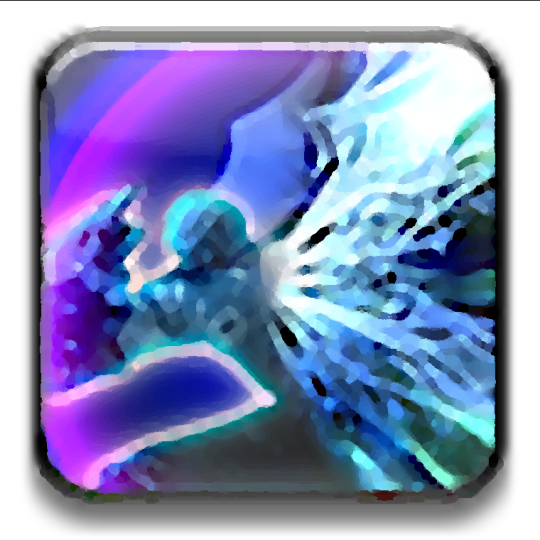
none of the below is directly stated in the script, but imo it's a fairly obvious gloss on what the game presents, if you assume a paladin warrior of light. spoilers for all expansions through the end of 6.X.
in the new version of steps of faith, as vishap breaks through each ward protecting ishgard from attack, lucia mounts a final desperate effort to hold him back, with a very familiar looking animation:
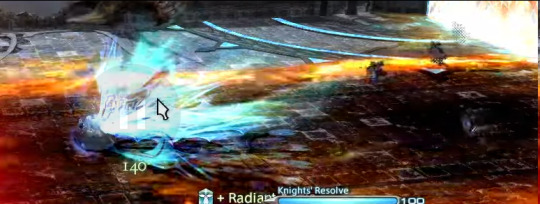
but even lucia can't hold back vishap's flame alone, so the temple knights surge forward to assist her. their efforts make the shield visually more powerful and larger. the temple knights here band together in defense of ishgard, and their knightly resolve to protect their home is the difference between victory and defeat.
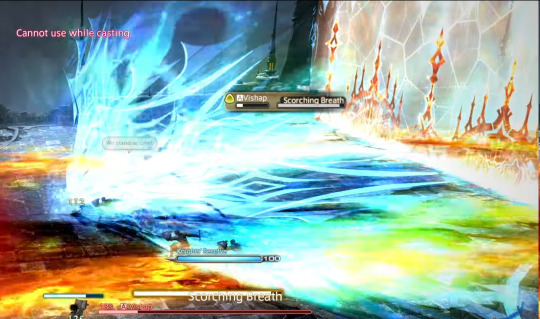
lucia and the knights do ultimately succeed in defending the last ward, as you have to defeat vishap before their shield falls or you lose.
later in heavensward, obviously, we will get ffxiv's most famous (failed) attempt at blocking something with a shield.
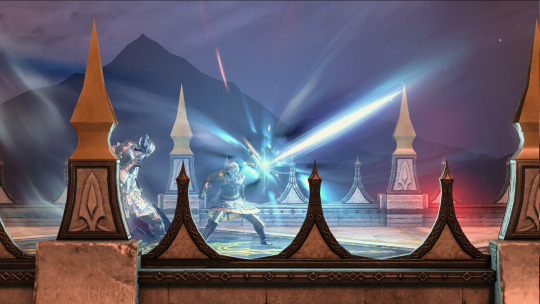
this moment can be read as fairly impactful on the warrior of light's development; as i've noted elsewhere, after the trauma of watching haurchefant bleed out in their arms at level 57, at level 58 paladins learn to channel their magic into healing (and it's called "clemency," or mercy. mercy for whom? who was guilty?), and as someone pointed out on that post, at level 58 dark knights used to get "sole survivor", letting them heal in response to a marked target's death.
for a time, you literally carry haurchefant's shield with you, and 3.3 very much literalizes in genre fashion the idea that even when you are standing alone, your fallen friends stand with you. you don't need to call any allies to stand at your side and raise their shields with you because they are already there, in spirit.
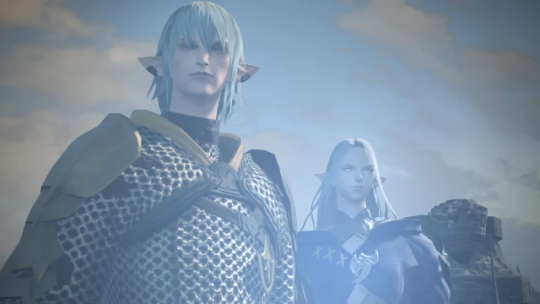
stormblood marks a pretty important turning point in the warrior of light as a combatant, in my opinion, and the text makes this clear in several ways. first, in pretty much all your jobs, you've now far exceeded your trainers and are pioneering new techniques. this is no less true of paladin, which for 60-70 abandons any trainers at all for you to show off your peerless skills in a tournament.
second, stormblood is straight up a story about you getting stronger. at level 61, zenos kicks your ass. at level 70, you kick his ass. why? because you fought and got stronger and developed incredible new techniques and became a one-man army.
for a lot of classes, this story lines up nicely with the big rotation changes or flashy new finishers on the way from 60 to 70. SMN is now busting out bahamut and casting akh morn; RDM gets verflare and verholy; DRG starts harnessing nidhogg's power directly through dragon sight and nastrond.
the tanks are divided in two: warriors and gunbreakers get huge damaging upgrades at 70 in the form of inner release and continuation, each of which lets them hit the same button many times for lots of damage and satisfying animations. paladin and dark knight get more protective abilities; dark knight gets the blackest night, and there's been plenty said about that already by pretty much everyone.
paladins get passage of arms. instead of a relentless new attack (and you get requiescat at 68, which is a way bigger deal for your dps rotation), your big reveal at 70 for zenos in your fight in ala mhigo is a superior way to protect your party, a shield that lets you stand for your allies so they never have to fall for you again. it's lucia's same shield, except you need no allies' shields to reinforce you, proof of your martial prowess and your ability to transcend limits, and perhaps in truth a reminder that you never really stand alone.
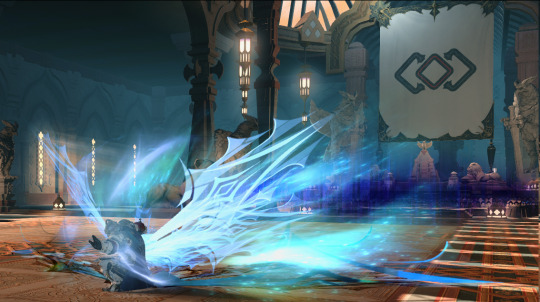
in many respects passage of arms should really feel like a paladin signature move to you now if you are playing it at this point, because you should be popping it in pretty much every fight (you are using your mits, right...?). basically every FFXIV fight has at least one big AOE with downtime that warrants passage of arms usage, usually after the mid-fight add phase with slowly filling bar. since that AOE usually drops during downtime, there's no reason not to pop passage of arms (which otherwise restricts your movement and actions), and even on normal, sometimes every little bit counts on a damage check even if it means dropping DPS (thinking here of harrowing hell P10N on release, which was...less consistent for a lot of roulette parties than you might hope).
so from 70 onward, passage of arms is in a sense a paladin warrior of light's signature move, and certainly the one a player gets to most actually enjoy (since if you're using it, you're by necessity not doing anything besides moving your camera and admiring your sick animation). it doesn't have any competition in terms of spectacle until confiteor, and those you're usually throwing out in the middle of movement.
it's such a signature, in fact, that the only other person shown using your one-person version of passage of arms is your greatest admirer, who studied your legend for over a century.
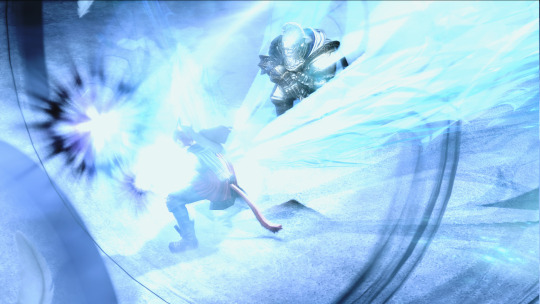
and it's when he fails (should've popped arm's length, bud) that the warrior of light decides they can't let their friends fall for them, and sends them away with the transporter beacon. this is all wrong: you were meant to die for them, not the other way around. yours is the shield that stands between your allies and defeat. it is you who will win this passage of arms and break your opponents lance. and you do.
and then later, when they need to quickly establish zero's domain as a place of fallen grandeur, the home of someone who once believed in heroes but is now a cool and cynical vampire hunter d, what do they use? a decayed statue of someone in the paladin endwalker gear doing the passage of arms animation, of course.
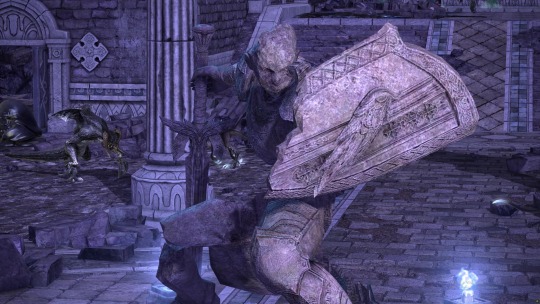
from a visible instantiation of knighthood as a joint effort to defend what is sacred, to a tribute to the fallen friends whose memories stand by you and animate you, to a symbol of the wol's power as emulated by their allies or darkly mirrored in other shards.
not bad for a mit button you hit once per fight and otherwise never think about!
#the one-handed passage of arms animation is from a mod that afaik is no longer available#it was junjou laina's eikonic paladin mod but the creator appears to have pulled the version i used#pld#ffxiv#the new steps of faith is a solo duty and there's no way i'm doing all that NG+ for two screenshots#so i got those from youtube (sources in the links)#haurchefant greystone#g'raha tia#lucia junius#tbh i'm corny so i was slightly miffed when g'raha jacked our paladin swag to do passage of arms in an important story cutscene#so placing it in context as him emulating you made me enjoy it a lot more lmao. i'm petty!#meta: durai report#warrior of light ffxiv
898 notes
·
View notes
Text
"I'm the quiet you've been longing for." Or, in other words, Gentleman Death.

So yeah, there are people, rightly, laughing at Armand calling himself the "quiet" that Daniel's been longing for because if you know anything about their relationship, particularly with how it started, it was anything but quiet. Quite the opposite in fact.
But see, I think, when it comes to the moment in the image above, that is actually the whole point. Because this moment isn't from some point when they are romantically together. I think this moment is from when they first really meet and speak to each other after Polynesian Mary's. More importantly, I think this is sometime after Armand had stopped Louis from killing Daniel.
There is a great observation/analysis post here that notes the clothes both Armand and young Daniel are wearing, and how they match up to what they were wearing that night when they first encountered each other at Polynesian Mary's. So this moment above being either later that same night, or maybe even the next night after Louis attacked Daniel matches up.
And this moment is very much Armand offering Daniel an "easeful death." Namely, killing him, probably because of what happened with Louis. Armand likely only stopped Louis from doing so because he knew Louis would feel guilty about it later, as Louis doesn't actually like to know anything about his victims before he kills them. So Armand likely stepped in and stopped Louis to spare him from that and such guilt.
However, Armand probably also thinks Daniel now knows too much to risk letting him live. And so is going to kill him himself. And I think what we are seeing here, above, is one of the ways Armand will sometimes present himself to his victims. And I think it is something he learned from Lestat, which is to be "Gentleman Death."
It's been noted by the writers of the show that they were looking to drawn things from Anne Rice's short story, Interlude with the Undead, for Armand in Season 2. (A short story, btw, which you can read online here and here.) And, of course, the line about "easeful death" that we hear in the trailer can be found in that short story, not once but twice:


But if you notice, during the first passage, Armand also talks about being "Gentleman Death." The same exact thing Lestat said to Armand to explain his outlook on being a vampire during the time period when they first met; and basically upending Armand's entire worldview (and cult) under Les Innocents.
From The Vampire Lestat:

From Interlude with the Undead:

From the opening of Interlude with the Undead, we know that this whole short story was actually Louis telling Daniel something Armand had told him. Well, I think not only has the show cut out the middleman on that, but I think what they are about to do is show how very much Armand, in his own way, embraced Lestat's Gentleman Death mission statement for a time. Probably for a long time.
In the show, I think we are going to see Lestat give Armand his Gentleman Death monologue during the scene when these two images happen:
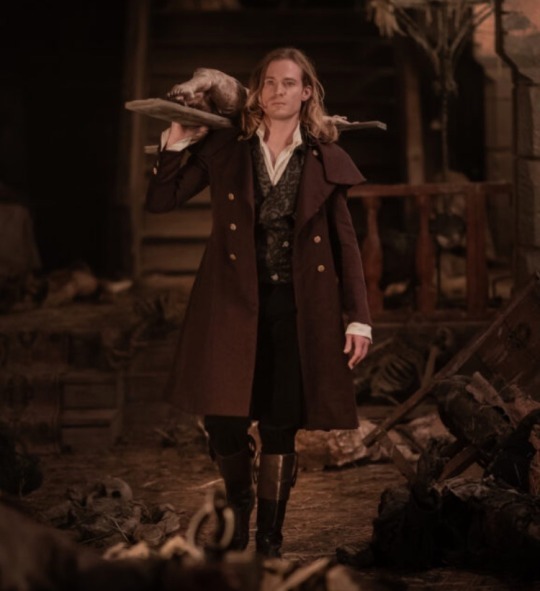
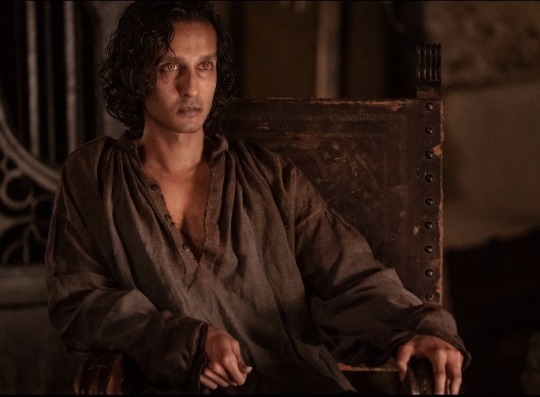
And I think, by the time Louis encounters Armand in Paris, we will see that he has, in his own ways and methods, adapted to that ethos of being Gentleman Death.
However, time does march on. And I do think Armand will begin to see presenting himself as such is beginning to not fit with the times he is now in. But it will still be one of the things he still will present himself as.
At least until Daniel.

Because I really do think when Armand presents himself in this way to Daniel, being a "quiet" (ie death) that he says Daniel has been longing for? Daniel is going to flat-out reject that.
Because Daniel doesn't want to die, no matter how many drugs he takes or the reckless behavior he may sometimes exhibit (during this point in time). What Daniel really wants is to live forever. The reason Louis attacked Daniel as he did was because Daniel asked Louis to make him immortal.
Death? Quiet? Hell no. Give Daniel Molloy immortality, thank you!
So Daniel is going to ask the same thing of Armand he asked of Louis. Which is for Armand to make him immortal.
And just like in the book? Armand is, at first, going to be taken aback. And then, intrigued by this brash (and beautiful) human:

This human whom Armand is sure is going to go completely mad at some point by the knowledge that vampires actually exist. But hasn't gone mad, no not yet:

So yeah, I feel that the "quiet you've been longing for" moment in the trailer is the moment when Armand presents himself as his own version of "Gentleman Death" and it flat-out doesn't work, probably for the first time ever. And that it doesn't work with Daniel is what starts The Chase between them in the show's universe; the show leaving out the 3-days or so that Armand locked Daniel in a cage before that, of course.
And all because of something Armand has been doing since Lestat first upended his life under Les Innocents centuries ago did not work on this one particular mortal. So, instead, Armand let him go to chase him instead.
And to hell with trying to seduce this human with promises of "quiet" because that sure as hell didn't work last time.
#Armand#The Vampire Armand#Daniel Molloy#Lestat de Lioncourt#Devil's Minion#The Devil's Minion#Interlude with the Undead#The Vampire Lestat#Interview with the Vampire#amc iwtv#iwtv#iwtv meta#iwtv Season 2#iwtv Season 2 speculation#Daniel Malloy
472 notes
·
View notes
Text

why did simon in tftsa go through an actual arc of remembering and accepting his and jace's weird gay thing.....
"i mean, it was special wasn't it? "no!" said simon." -> "was that a special moment for you?" simon asked. "one that you wanted me to remember that we shared?" like is it just me seeing this. am I just going insane. have I lost it


i have no words.
#one thing about cc she will NOT let the jace/simon ship scene go#the first passage i posted was from the very first story and this one is from the 2nd last one btw#like am i just seeing things. am i just suffering the brain rot of reading 8 tsc books in a row#i dont know. i dont know anymore. all i know is cc was giggling at her keyboard when she wrote this#and i am giggling along with her. reluctantly..... but i am.#vic reads tftsa#born to endless night#welcome to the shadowhunter academy
244 notes
·
View notes
Note
⭕️Hey Bones! Is it ok if you explain and/or elaborate how Crowfeather is abusive to Breezepelt if please?⭕️
I do KNOW that crowfeather is indeed, abusive to Breezepelt, due to the fact that he emotionally and/or physically neglected him - with child neglect being known to BE a form of child abuse - and I also heard that he slashed and/or hit him within one of the books, which I believe is in the book Outcast, in chapter 16.
But I also wish people would talk and be informed about it more within the fandom, because in the parts of the fandom I’ve known portrayed Crowfeather’s neglect on Breezepelt as negative and bad, but not in a way that made me think and/or feel: “Wow, that’s pretty bad. That’s…actually abusive.” I suppose? So I hope more people will talk about it more in that type of way.
Also, please be aware that I have NOT read PoT, OoTS, etc. or barely any warrior cats books, since the majority of the information I got from the series is from the wiki and the fandom, so that probably explains why I didn’t know this part of Crowfeather’s character is as bad as it actually is until now. Also, feel free to talk about Crowfeather’s abuse on Breezepelt I haven’t mentioned and/or don’t know right now as well if you want.
I’m SO sorry that if this ask is unintentionally quite long, and feel free to make sure to take all the time you need to answer it. Thank you!
OH LET'S GOOOO
Breezepelt is both physically and emotionally abused by Crowfeather. I'm not talking about only child neglect; he is screamed at, belittled, and even once hit on-screen.
The fact that Crowfeather both neglected and abused him is very important to the canonical story of Breezepaw. There's actually a lot more to this character than people remember! Even from his first appearances he displays good qualities, a strained relationship with his father and adult clanmates, and is clearly shown to be troubled before we understand why.
As many problems as I have with the direction of Breezepelt's arc (especially Crowfeather's Trial), his setup is legitimately a praiseworthy bit of writing from Po3 which carries over into OotS. To say that Breezepelt was not abused is to completely miss two arcs worth of books SCREAMING it.
BIG POST. Glossary;
INTRO TO BREEZEPELT: The Sight and Dark River
ABUSE: Outcast, Social Alienation, the Tribe Journey.
DARK FOREST: How these factors push him towards radicalization.
For "brevity," I'm not getting into anything post-OotS. I'm just showing that Breezepelt was abused, the narrative wants you to know that he was abused, and that his status as a victim of child abuse is CENTRAL to understanding why he is training in the Dark Forest.
INTRO TO BREEZEPELT: The Sight and Dark River
Our very first introduction to Breeze is when Jaypaw walks off a cliff in the first book of Po3 and is rescued by a WindClan patrol. He's making snarky remarks, and Whitetail and Crowfeather are not happy about it. Whitetail snaps for Crow to teach his son some manners, and Crow growls for Breezepaw to be quiet.
But our proper introduction to him is at his announcement gathering, when Heatherpaw playfully introduces him as a friend,
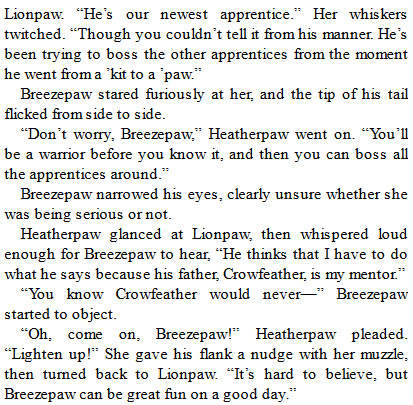
From the offset something's not entirely right here between Breezepaw and his father. He's cut off by Heatherpaw here, but he's touchy whenever his father is involved, and we're not entirely sure why.
Throughout Book 1, he's just rude, with a notable xenophobic streak. He's a bit of a mean rival character for Lionpaw, as they're both interested in the affections of Heatherpaw and make bids to get her attention, but nothing particularly violent yet.
He participates in the beloved Kitty Olympics and gets buried in liquid dirt with Lionpaw, basically a rite of passage for any arc.
(And Nightcloud has a cute moment where she watches over them until they fall asleep)
As the books progress, the relationship between Crow and Breeze visibly deteriorates. They start from being simply tense with each other in The Sight, to the open shouting and hitting we see in Outcast.
In the very first chapter of Dark River, we learn where his behavioral issues are really coming from;

Crowfeather.
Breezepelt is getting xenophobia from his father. Occasionally he says something bigoted and his dad will agree and chime in, and those are the only positive moments they have together.
(Note: In contrast, Nightcloud explicitly pushes back against xenophobia, chiding Breezepelt for his rudeness to Lionpaw in back in The Sight, Chapter 21. The Sight is the book where a lot of "evidence" that the Evil Overbearing Woman is actually responsible for the rift between father and son but. No. She's not. Though she can be overprotective; Crow and Breeze have a bad relationship when she's not even around in Breeze's first appearance and even his Crowfeather's Trial Epiphany refutes it. Anyway this post isn't about Nightcloud.)
So he starts acting on his bigotry, accusing cats in other Clans of stealing, running really close to the border. What's interesting though, is that this is not entirely his doing. The first time we get physical trouble from Breezepaw, DUSTPELT aggressed it. Breezepaw and Harepaw were just chasing a squirrel and hadn't yet gone over the border at all.
We learn that WindClan is teaching its apprentices how to hunt in woodland, and tensions between the two Clans is starting to escalate as ThunderClan isn't entirely trusting of their intentions.
The second time, fighting breaks out over him and Harepaw actually crossing the border and catching a squirrel. WindClan is adamant that because it came from their land, it's their squirrel. So it's as if Breezepaw is modelling the aggression around him, learning how to behave from the older warriors and his father.
When he joins Heatherpaw and The Three to go find Gorsetail's kits in the tunnels, he's grouchy towards the ThunderClan cats, but very gentle with the kittens. Notably so. When Thistlekit is dangerously cold, he cuddles up next to her, and even assures Swallowkit when she's scared,

Through this entire excursion, he's the one in the comforting roles for the kittens. Breezepaw is the one who is taking time to tell the kits they'll be okay, that he'll protect them, and physically supporting them when they're weak, even when he's terrified.

And it's always contrasted to Heatherpaw who's way more 'disciplined,' as a side note. It's a detail I'm just fond of.

All this to point out,
Breezepelt displays his best qualities when he's away from the older warriors of WindClan, and he's at his worst whenever he's near Crowfeather. Even while he's essentially just a bully character for The Three to deal with. He's gruff but cooperative when it's just him and Heatherpaw interacting with The Three, but mean when there is an adult to please.
We're getting to the on-screen abuse now, but Po3 actually sets up Breezepaw's troubles and dynamics well before it's finally confirmed that he is a victim of child abuse.
ABUSE: Outcast, the Tribe Journey.
In Outcast, Breezepaw's problems have escalated into open aggression towards cats of other Clans, and is now a legitimate concern for his own safety. Yet, he's spoken over by older warriors, and reprimanded at nearly every opportunity, right in front of the warrior of another Clan.
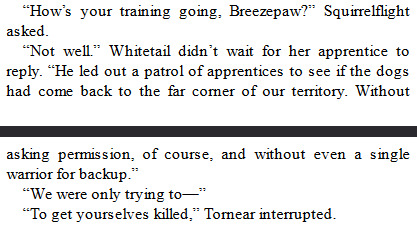
Squilf just asked the poor kid how his training was going, and then Whitetail JUMPS to talk over him so she can complain, RIGHT in front of his face.
They can't even wait until they're alone to grumble something rude about Breezepaw, who is still just a teenager here;

They taught him already that a bit of prey that runs off their own territory still belongs to WindClan, encourage him to blow past borders in pursuit, and started a battle with ThunderClan over this. And then they're pissed off at him for being aggressive, thinking it's deserved to scold him in public.
When Onestar announces that he wants Breezepaw to go on the Tribe Journey, he's devastated by it...

Because he thinks WindClan doesn't like him, and he's right. He's gossiped about, torn into in front of a ThunderClan warrior, and even his own dad doesn't want to be around him. It's clear that Breezepaw's impulsive "codebreaking" behaviors are a desire to prove himself, and once you realize that, the way that he's being alienated is heartbreaking.
But Wait!! Hold on a minute! Where did he get a "patrol of apprentices" from to confront the dogs with, exactly?
Simple. Breezepaw CAN make friends! He actually values them a lot! So much that it's the first thing Crowfeather snaps at him over, out of frustration that his son is also being forced on this journey with him. It's an angry response to his child having emotional and physical needs, resentment that will continue all journey long.

Note that it's plural, friends. Breezepelt has multiple friends, at least one who is not Heatherpaw, and she promises to say goodbye to them.
Up next, they state over and over, Crowfeather and Breezepaw do not like each other. Crowfeather resents being around him and dealing with his rudeness, embarrassed and angry, and Breezepaw is absolutely miserable being sent on a journey to the mountains with a man who hates his guts.
The whole while, Crowfeather is brooding longingly about Feathertail, already thinking about her as soon as he kitty-kisses Nightcloud goodbye, his eyes looking somewhere distant. He makes a jab about loyalty when Breezepaw doesn't understand why they're helping the Tribe.
Breezepaw gets smacked after he's "shoved" at Purdy and acts rude to him, while the other three manage to be polite (while still having internal dialogue about how stinky he is).
Without so much as a, "cut that out," Crowfeather raises his paw and hits him. Breeze is quiet after that.

I don't give a shit how rude your teenager is being. Do not hit kids. Being throttled on the head is not okay.
In spite of the Three not liking Breezepaw, or even Crowfeather, they're constantly noting that their arguments are not normal, and that Crow is a cold, unsupportive father who digs into his kid constantly, and the only time he ever DOES "discipline" his child it's through immediately smacking him.
At one point, the apprentices get hungry, and decide to foolishly hunt in a barn that they know has dogs in it against Purdy's warnings. Once again, JUST like the first two books, Breezepaw is more friendly when Crowfeather is not around.
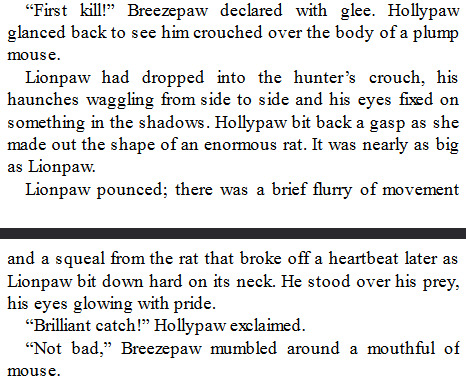
EVERY time he is alone with cats his own age, he's grumpy but cooperative. Even enthusiastic at times! The minute Crowfeather is in the picture, he's nasty.
Naturally, the dogs show up, but Purdy rescues them. Though Brambleclaw also chews his kids out (and i have strong opinions about bramble's parenting style for another time), Hollypaw is taken aback by the contrast of what a scolding from Brambleclaw looks like vs how Crowfeather reacts.

The narrative is desperately trying to tell you that the way Crowfeather treats his son is not normal.
And then Crowfeather is pissed off that Breezepaw is exhausted from running for his life from hungry dogs,

And he's constantly losing his shit whenever Breezepaw says something as innocuous as "dad im hungry"

Then, Breezepaw is made to watch his dad pine over the grave of a woman who died long before Crowfeather was even considering his mother for a mate. What he feels is jealousy, because he knows his own father doesn't love him anywhere near as much as he loves the memory of Feathertail.
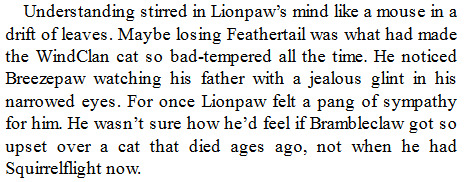
This really goes on and on and on. The ENTIRE trip is like this, with Crowfeather treating Breezepelt poorly, giving him a smack before even verbally warning him, pushing him past his limits and blowing up on him when he asks simple questions about eating or resting.
It all comes to a head in this one exchange, towards the end. Hollypaw ends up snapping at Breezepaw for his rudeness, before having an epiphany.
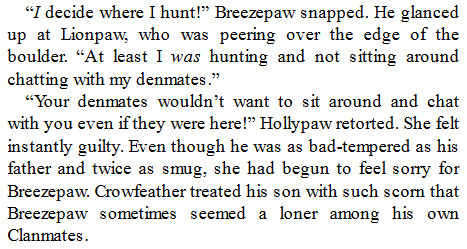
It's explicit. Crowfeather's emotional abuse, his "scorn" for Breezepelt, is what is driving a wedge between him and all of his older Clanmates. Between EVERYONE in Breezepelt's life who wasn't already his friend. This awful treatment is only making him worse and worse.
Realizing this, she has more sympathy for him, but it's too late. He continues to be rude to her because he feels insulted, and her patience completely runs out. She's just a kid. They're both just kids. She's not responsible for fixing him when he's pushing everyone away at this point.
That's the end of Breezepelt in Outcast. It can't be helped anymore. Any spark of friendship they had together in the barn, or in the tunnels, is gone.
As the series progresses, Crowfeather continues to refuse any personal responsibility for the mistreatment of his son, even pinning all of Breezepelt's behavioral problems on Nightcloud. He is a cold, selfish father who only ever thinks about his own pain and reputation.
DARK FOREST: How these factors push him towards radicalization.
Everyone talks about the Attack on Poppyfrost, which happens in the first book of OotS, in oversimplified terms. YES he is going after a nun and a pregnant woman. I've never said that's not Bad.
But no one talks about "WHY", and that reason is NOT just that he desires power like so many other WC villains. Breezepelt makes his motivation very clear on the page.
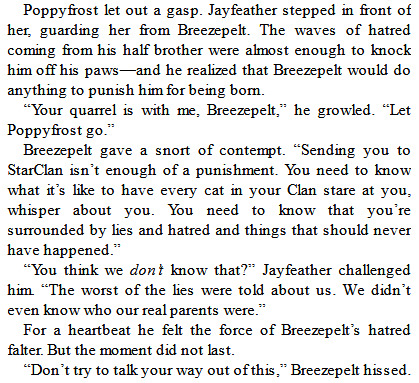
Escalating to violence was about making Jayfeather feel the way that he does.
When Breezepelt says that he wants Jay to be surrounded by "lies, hatred, and things that should never have happened," he's talking about the way HE grew up, knowing his father never wanted him, and that his Clan HATES him as a result. Killing Poppyfrost is about trying to frame Jayfeather for her murder, so ThunderClan won't trust him anymore.
When Jayfeather points out the simple truth that what Breezepelt is saying doesn't make any goddamn sense, his hatred "falters." He's blaming his half-clan half-brother for his own treatment because of the reveal, but totally failed to consider that JAYFEATHER'S ALREADY GOING THROUGH IT... so his response is just this pitiful, "s-shut up, man."
Then the ghost of Brokenstar and Breezepelt bounce him back and forth between them like a beach ball for a bit until Honeyfern's spirit shows up.
Breezepelt's childhood abuse and social alienation was a hook that the Dark Forest latched onto, to reel him in. His anger at his half-brother is so obviously misplaced that its absurdity was something Jayfeather pointed out.
We soon learn that it's the Dark Forest who's planting that ridiculous idea in his head;
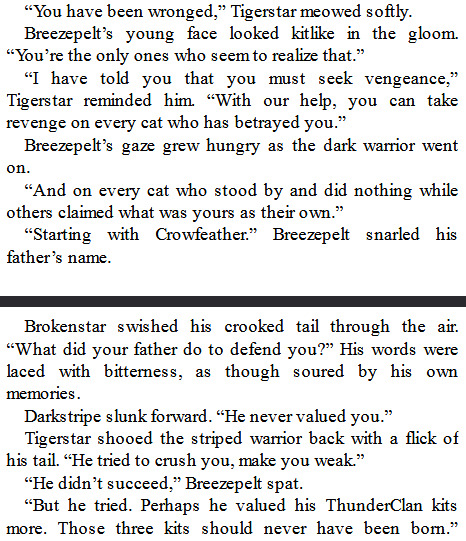
The narration is SCREAMING, "The Dark Forest is validating the anger he feels towards his father, and redirecting it towards The Three." He's described as 'kitlike,' Tigerstar's eyes are compared to a hypnotizing snake.
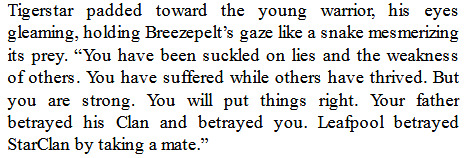
This prose could not make it more obvious if it drove to your house, beat you with it, and then spoon fed you the point while you were hospitalized.
At the end of this scene, Tigerstar sends Hawkfrost to recruit Ivypaw. This scene where Breezepelt is being lovebombed, and the command to start grooming Ivypaw, ARE LINKED. That was a choice.
A VERY GOOD choice! Again, as many issues as I have with OotS, its handling of indoctrination is unironically fantastic, and it owes a good amount of that to the outstanding setup of Breezepelt that was done back in Po3. And that setup doesn't work if Crowfeather was merely distant.
Breezepelt was abused by his father, both verbally and physically. It drove him to be more aggressive to prove himself, modeling the battle culture around him. The adults of WindClan judged him based off Crowfeather's responses, shunning and belittling the 'problem' teenager, which eventually drove Breezepelt to the only group that he felt "understood" him.
In a book series that is RIFE with abuse apologia, this is one of the few times that there's any behavioral consequences for abuse and the narrative holds the perpetrator accountable for it.
But people hear Crowfeather's deflective excuse in The Last Hope where he says he never hated him, blames Nightcloud for everything, and just lick it up uncritically.

Gee whiz, I wonder why the guy who never blames himself for any of his problems would suddenly say it was his ex-wife's fault. Real headscratcher!
(Crowfeather's Trial then goes onto, for all my own problems with it, also hold Crow accountable as the reason why Breezepelt turned out like he did. But that's a topic for another day.)
#This is headcanon territory here. But one day I realized I can read Breezy-P with BPD and he became a blorbo.#Never been able to unsee it and it massively endears him to me... Breeze Pelt Disorder...#I actually REALLY hate how his arc was resolved and strongly feel that he should have progressed into a bigger problem#But I equally strongly feel that being redeemed is the ideal ending for him#so if it was between him being pure evil/redemption death or the awful halting we got at the end of oots....#I'd pick the halting over him being pure evil or a redemption death.#I think BB made me REALLY fall in love with him. He's my sweet cheese. My good time boy.#Bones when he sees an angry black cat: ''i can fix you. first i must break you. but then i can fix you''#Like. what i dislike about where he went is that even if your anger issues came from abuse. you STILL are responsible for your actions#but in the end getting that Shitty Dad Approval fixes him. Not his own growth or self-reflection.#it feels like BREEZE gets his agency stripped away for HIS ABUSIVE DAD'S character arc#It retcons in a reason why Breezepelt is not still a problem and then he faded into the background.#while Crowfeather continues to get supporting roles and every now and then Breeze now looks at him fondly#BLECH.#Crowfeather#Breezepelt#Abuse#Child Abuse#Warrior Cats Analysis#And now you know anon!!
648 notes
·
View notes
Text
Dirges in The Dark by WixWrites

Before I start, let me just say: Ranchers! Scarian! Hermits and Life Series and Empires characters! Sheriff Jimmy! Sheriff Scar! Criminal Tango! the Wild West! Treebark and Ethubs!
RANCHERS. THE WILD WEST. CREEPING ELDRITCH HORROR.
Whoo, that was a rush.
I'll be honest; I think this book would have come out much sooner if not for my decision to add-in a whole lot of stuff into the text and pages. It got to the point that the original cover would have been a wanted poster at the front and a sheriff's report at the back!
I had to restrain myself, lest this book would never get finished at all. It's already been 59 days since my last post, and doing the original cover would have stretched the days even further. So I had to follow the mantra: Finished, not perfect. Besides, nothing says I can't make another version in the future...


From the moment I finished this fic, I knew it would become a book. But at 143,412 words, Dirges in The Dark by @twodiamondhoes would stretch my ficbinding skills to the limit and would be the second-ever bind that would reach past 250 pages (the first was an MCYT Sleepy Bois fic that predates this blog that I want to redo).
Eventually, the full typeset took up 520 pages! And as such, I finally decided to use extra support for the entire textblock. From an old pair of pajamas, I backed strips of fabric with glue and paper before cutting it into tapes, forming a crucial support for the various weaves along the spine. I then covered the entire spine in brown wrapping paper for even more strength.



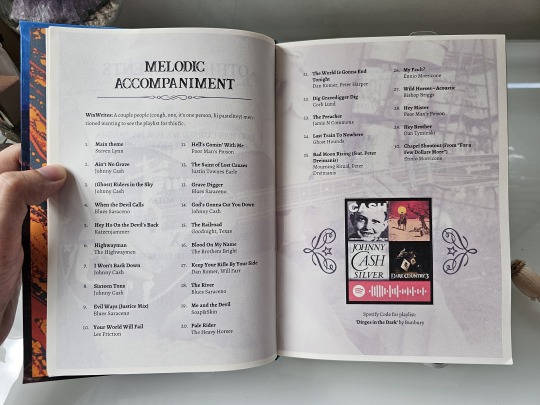
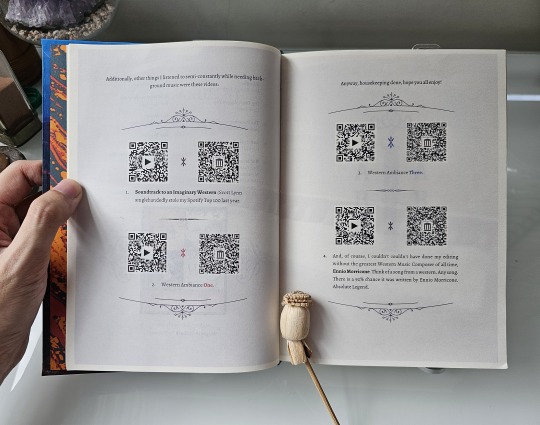
For the title and headings, I scoured for and found several typefaces, dingbats, and vector graphics which really evoked the fic's Western and Gothic vibes. I also took some inspiration from fellow ficbinders in the Renegade Publishing group for the style of layout and formatting throughout the book, such as using faded images in the background of these pre-story pages.
I wanted the reader to be immersed in the Wild West from the get-go, so having such images from the start — before the story even begins — felt very appropriate. I tried to make them thematic to the information presented, like a singing cowboy for the music playlist pages, but I think I made the image too faint to be seen!
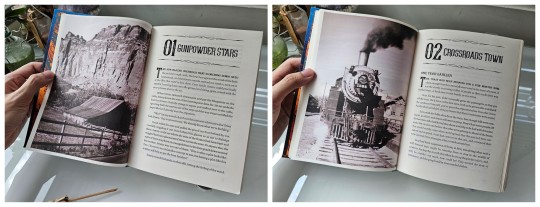
As for the chapter openers, I experimented with some layouts before finalizing on what you see: photos taking up one entire page on the left with the chapter titles and opening paragraphs on the right.
Just like my last bind, I want to make the reader feel immersed in the story and also bring out the mood of that particular chapter. This, however, led me to entire days of scouting and scouring stock photo sites just to find the right pictures for 11 different chapters. 4/10 would not recommend for sanity.

Given that the story uses a number of foreign words, old slang, and specific Wild West-era terms, I added a plethora of footnotes at the bottom of some pages for extra context and meaning.
I also wanted to be playful and make certain story parts, such as characters receiving letters and notes, really look like they're a part of the story. So I cropped old paper textures and fished out old fonts from the past to make them look as if they're actually there, pasted against the paragraphs!
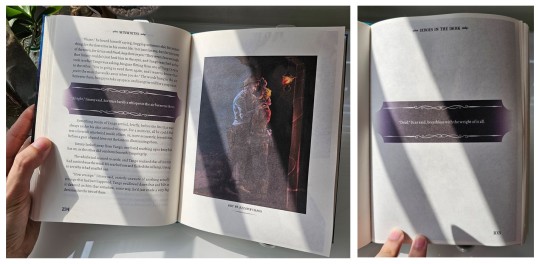
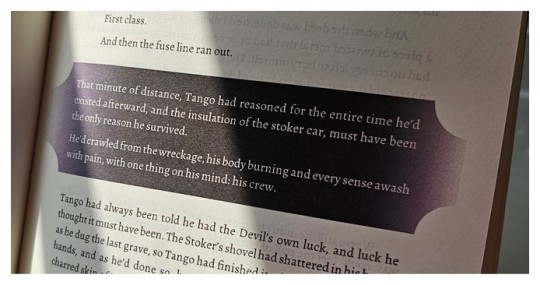
More importantly, there were some specific parts of the fic that felt super important and I wanted to highlight these passages, especially the Deals made by the characters throughout their arcs. Given DiTD has a certain affinity with eldritch darkness, I decided to highlight such paragraphs by backlighting them against a band of pure black. Besides being thematic as hell, I made the bands have curved edges and decorative lines to add a certain western-gothic touch!
It was from this that I begin to think "what if I can color entire pages to convey the mood and setting?"

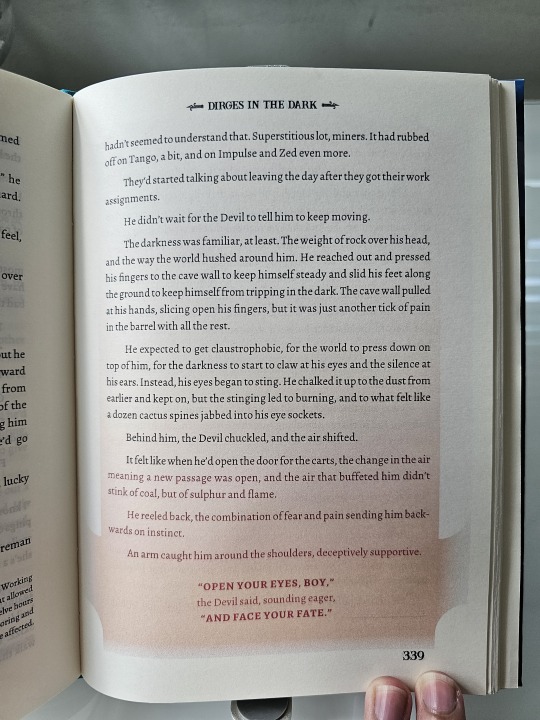
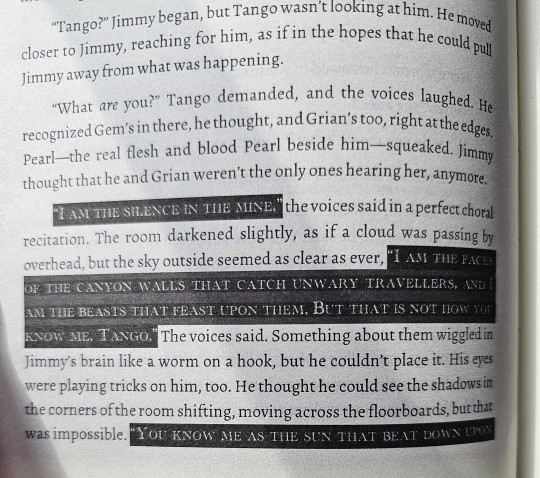
...Which led to the madness in these pages. I can't reveal too much because of spoilers, but there are certain times when the characters end up in situations where the very light turns to dark. Or they end up in hellish situations. Or the eldritch creatures began to speak.
It took some creative brainstorming to figure out how to show the mood of such scenes in printed pages, but I eventually figured out that I need find the right fonts, change their colors from black to white, and then change their backgrounds from white to dark to highlight them all! The power of formatting!
There's a lot more pages where I went wild with such shades and fonts, but I ain't revealing in public because spoilers!
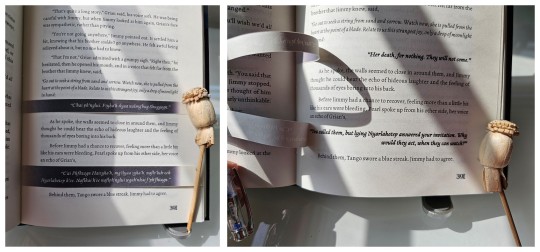
But undoubtedly, this is the biggest experiment I have made with this bind. There is a certain part where Grian and Pearl spoke in eldritch R'lyehian / Cthuvian, and I want to convey the sheer strangeness of the speech and it's meaning. Something outside the box.
Luckily, I have an inspiration in fellow fanbinder @mythrilthread, who made an amazing fanbind that used vellum overlays to showcase the speaking of alien languages and what they mean in English. AND IT LOOKS SICK AS FUCK. When I finished reading Dirges, I knew I had to emulate this form of language translation, so I printed the eldritch speech, cut it, and pasted it onto the spine to give a similar effect of strangeness, and IT LOOKS SO COOL!!!
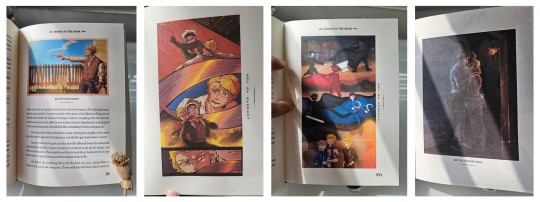
And lastly, I just had to include some of the amazing fanart made by readers into the book! All of these are placed by their corresponding text and chapters, and they all look so cool!
So I want to give a special thanks to @azzayofchaos, @leafdoodles, @hybbart, and @foxyola for granting their permission for me to include their incredible works into this bind! The dark shades and page formatting is one thing, but these works truly make this book feel so much more alive!
All in all, this bind was an odyssey in the making. I experimented with page formatting, layout wizardry, and bookmaking methods that I haven't tried before. While I know I could do better, I am beyond happy to see this work finished!
And once again, a thousand thanks to @twodiamondhoes / WixWrites for crafting an amazing story!

#bookbinding#fanbinding#ficbinding#my bookbinds#mcyt#Hermitcraft#Life SMP Series#Trafficblr#Empires SMP#Dirges In The Dark#jimmy solidarity#tangotek#team rancher#solidaritek#Wild West#Old West#American West
178 notes
·
View notes
Text
One Piece Novel: Law — a short analysis
So, after a long time trying to get my hands on the Law light novel, I was finally able to read it recently! And, because I'm an obnoxiously intense person who can't just be normal about things, I found myself taking notes about everything I judged interesting.
And I thought I could share! So here's a mostly improvised essay about the Law novel, how it portrays Law and what it reveals about him as a character.
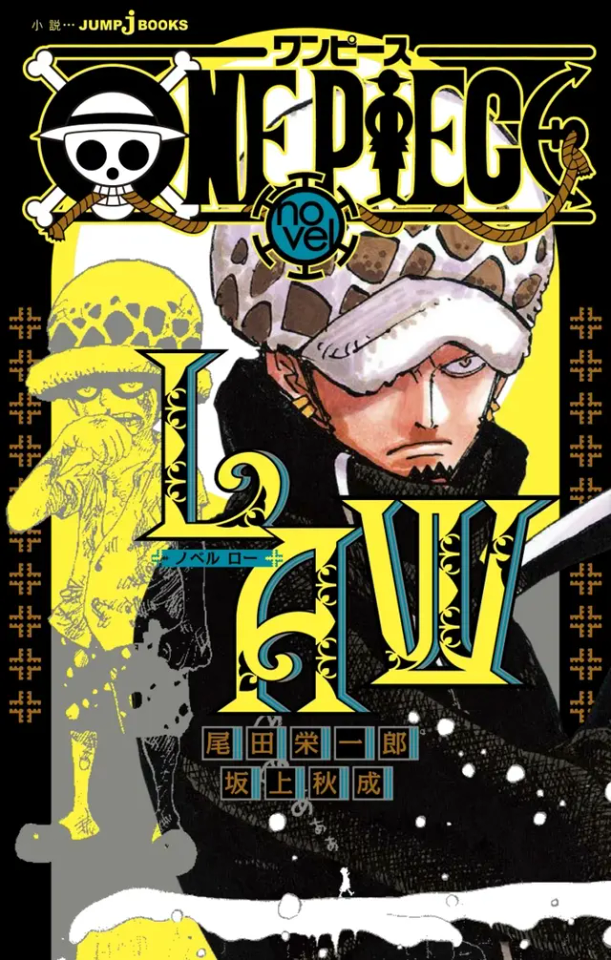
Some notes before I start:
The edition I've read of this novel is the official Spanish translation by Planeta. When quoting and mentioning numbered pages, I'm referencing that edition.
I originally posted this on Twitter as a thread! If it sounds familiar, that might be why.
For those who haven't read the novel and might want to: be mindful of some trigger warnings, including gruesome medical descriptions, suicidal thoughts, mentions of abuse, and violence in general (I won't be touching on these subjects here though).
These are just my personal impressions, I'm not trying to tell anyone how they should interpret the novel or Law's character. I'm just doing this for fun!
The story takes place right after Cora dies, following young Law's journey as he makes it to Swallow Island and desperately tries to survive. There, he will meet Bepo, Penguin and Shachi, as well as Wolf, a novel-exclusive character that welcomes Law and the boys into his home as a family.
Overall, it's a very short read, agile and straightforward. The style is very juvenile, but that was to be expected, and I'd say it does a pretty good job at capturing the feeling of watching a One Piece episode. The novel does kinda feel like a mini arc.
I'm unsure if light novels can be considered 100% canon in general, but since the contents don't contradict anything from what we've already seen in the manga/anime, I'm going to assume we can at least take the events described in this one as canon.
But I'll leave the plot aside a little bit to focus more on Law's psyche, analyzing everything in the novel as material that helps us further understand him.
The entire book (save from a few specific passages) is written from Law's point of view and in first person, so it offers a more in-depth look at his way of thinking, motivations and ideals.
What I find most interesting in this sense is that the whole story is very centered around Law's kindness. Though he does admit several times that he had wanted to see the world burn when he was under Doflamingo's care (as we already know from the source material), the novel makes it very obvious that Law's true nature is compassionate. His inner voice even explicitly states that he enjoys helping and making others happy. (Quotes roughly translated from Spanish):
P. 27: "And I felt very comfortable collaborating with the task of helping others."
P. 92: "Knowing that I was going to free a person from their pain [...] gave me a joy I had never experienced before."
P. 136: "Just imagining the surprised faces of the Old Man, Bepo and the others brought a smile to my face" [when planning on getting fresh fish for dinner as a surprise].
And, despite living under Wolf's motto of "give to take," Law never expects anything in return for any of his good actions. In fact, he gets furious at Wolf himself when, after saving his life, the old man insists on giving Law anything he demands as compensation.
P. 120: "I didn't save you because I wanted a reward!" [...] They [Bepo, Shachi and Penguin] burst into tears of happiness when they realized that you had survived. That's more than enough for me! [...]" I won't let you belittle their tears!"
But even then, Law keeps arguing that he only saved Wolf "on a whim," much like he would say years later when asked why he chose to save Luffy's life. This is a common theme throughout the whole book (which is also pretty obvious in the manga)—Law doesn't recognize his own kindness.
It's not modesty or shyness, his inner monologue makes it very clear that he doesn't see himself as good-natured, and is often confused at his own motivations.
In their first meeting, when Bepo asks him why he is so nice to him, Law doesn't know what to answer; and after that, when Law finds himself wondering why he's trying so hard to save Shachi and Penguin despite their past history, he blames it all on "doctor's pride."
P. 48: "I wasn't even a good person."
Still, regardless of what Law might think of himself, living in Swallow Island seems to be making him progressively gentler. He was wary and hostile towards Wolf at first, but eventually lets himself trust people again, trying to honor Cora's memory and what he taught Law.
In Swallow Island he builds his new found family little by little, though never letting go of Cora and what he meant to Law.
P. 39: "Cora and I were family, that's what I felt at heart, I had no doubts. We had loved each other without saying it out loud [...] Would I feel the same for the Old Man and Bepo eventually?"
Slowly, he starts finding comfort and joy in community. He lets himself be carefree around his new friends, treating them with open affection, laughing and being surprisingly enthusiastic (although he quickly starts taking his role as a leader very seriously, and sometimes avoids showing weakness around them so as not to worry them.)
Law even gets to become an active part of life in Pleasure Town, where he and the other boys are cherished after 3 years living and working there. He's comfortable with his role in the community and appreciates the people in town. His sense of duty towards them shines especially when the pirates arrive to attack the town.
Again, this contrasts with how Law sees himself even in the manga/anime, where he insists that he acts mostly out of selfishness and only seeking his own benefit (or, in the best of cases "on a whim.")
But the truth is that Law's decisions are almost always related to other people's desires.
In this sense, the concept of guilt is also key to understand Law's motivations and his relationship with the world as a whole. This is especially obvious when it comes to Cora—Law even briefly wishes that they had never met, so that Cora would still be alive (p. 128-129.)
In a way, guilt is what moves Law forward, and what slowly starts transforming into a thirst for revenge, into rage and hatred towards Doflamingo and possibly towards himself too. It's a kind of tragic guilt born out of love.
His love for Cora still haunts him, his last wish for Law is the big enigma that he tries to solve during his 3 years in Swallow Island: be free. What is freedom to Law? How can he fulfill Cora's request? This is the question that gives meaning to the novel.
We know that Law wouldn't feel free until finally taking down Doflamingo and avenging Cora's death many years later, but he hasn't reached that point of determination in the novel yet. Maybe that's what gives the narration that hopeful and optimistic tone, with a young Law that's still finding himself, experiencing wonder in loving again, and learning what it means for him to be true to his values. It's the start of an adventure, and its core theme is love.
The ending illustrates this very well; I especially like the moment where Law names the crew as they're setting sail:
P. 243: "Cora's love that he showed me, Wolf's affection, the trust I had in my companions. One word embodied it all: Heart."
It is love that gives Law a reason to keep going. And I'm so glad that the novel doesn't shy away from this fact and isn't afraid of sounding "sappy" or "corny," because I do believe emotion is a very important part of Law's character.
The epilogue closes with a very interesting quote in the last page:
"You hear that, Cora? This is my... This is our pirate crew."
It is unclear if by "our" he is referring to himself and Cora, as if dedicating this new beginning to him, or if he means him and his crew. I'd personally like to think he means it both ways. But in any case, it's interesting that he openly shares the honor of "owning" his crew with someone else. He is the captain, but not the owner. It's another little way in which his generosity is evidenced.
Overall, it was a very enjoyable read, and it left me wanting more. Obviously, it's not a literature masterpiece, but it gives a lot of interesting material for character analysis, which is super fun.
Finally, here’s a few fun facts for those who can’t/don’t want to read the novel but enjoy the little trivia:
The Polar Tang was built and designed by Wolf.
Law’s first tattoo was "DEATH," and he got it at a local tattoo shop in Pleasure Town at around 15 years old.
Shachi and Penguin are childhood friends and likely met through their parents.
Shachi had always wanted to be a hair stylist.
Law is bad at cooking.
Both Shachi and Penguin are good at cooking, especially Penguin, who worked as a waiter in Pleasure Town.
The Hearts’ jolly roger was collectively designed by Law, Bepo, Shachi and Penguin days before leaving Swallow Island.
Law decided the name of their crew upon setting sail for the first time.
And I think that's all! ♥ I hope my rambling was enjoyable at least!
Edit: I've now posted an analysis of the Ace novels too!
#trafalgar law#trafalgar d water law#one piece#one piece light novel#one piece novel law#one piece meta#irene.ppt
176 notes
·
View notes
Text

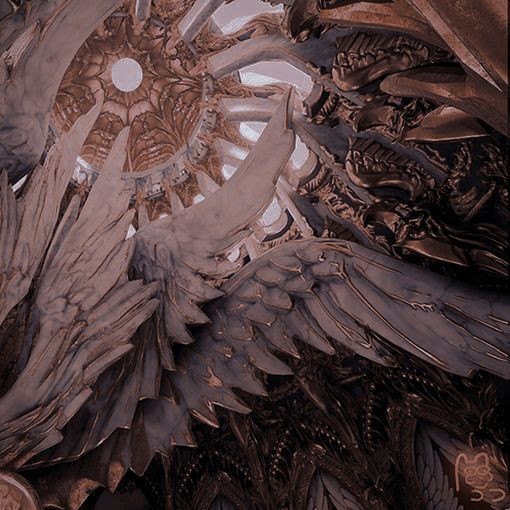
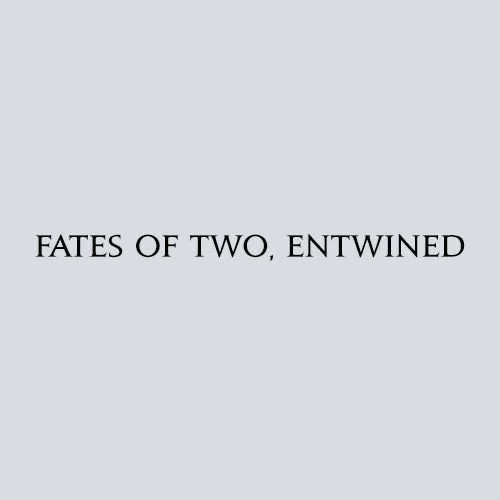

𝙴𝙻𝚈𝚂𝙸𝚄𝙼
"The final resting place of heroes and the virtuous.
When the concept of reincarnation gained currency in the classical world, the two Elysian realms were sometimes tiered — a soul which had won passage three times to the netherworld Elysium would, with their fourth death, be transferred to the Islands of the Blessed to dwell with the heroes of myth for all eternity.
Blessed be, the destination of two fated lovers..."
finally closing the book, you let out a soft sigh. it wasn't that you didn't enjoy mythology stories like such, far from it exactly. yet somehow, it always gave you a sense of familiarity, as if you had been through it before.
you shook your head. mythology were just stories people of ancient civilisations made up for their beliefs, of course. that was just a silly thought you had, right?
... right?
you felt a pair of arms snaked around your waist, warm and gentle as if you were made from porcelain. a familiar scent that belonged to your beloved, the comfort of which your confused soul sought for. lips leaving a fleeting kiss to your tensed neck, murmuring a voice, beautiful and soothing, you yearned to hear.
"i'm home."
right, you smiled. it didn't matter much, as long as he was still by your side.
"welcome home."
as long as your bond still prevailed.
your fated, your beloved.
𝙴𝙻𝚈𝚂𝙸𝚄𝙼 — 𝙰 200+ 𝙵𝙾𝙻𝙻𝙾𝚆𝙴𝚁𝚂 𝙴𝚅𝙴𝙽𝚃
(From 20th to 30th of November)
— by Lovejoy Studios
A Twisted Wonderland AU sets in an inestimable timeline, where the gods are very much real. And you, dear one, and your beloved are reunited at last, after centuries old of godly tragedies.
𝙰𝚋𝚘𝚞𝚝 𝚝𝚑𝚒𝚜 𝚎𝚟𝚎𝚗𝚝:
In Elysium, you may decide who shall play the god, and who shall play the human. Of course, both can be gods, or both can be humans.
I unfortunately cannot stop the tragedies you might have faced in your first lives, though, for Greek mythology shows no mercy for its heroes. That, dear one, you have to figure out yourself.
𝚁𝚞𝚕𝚎𝚜:
• You have to reblog this post, and spread the word to the best of your abilities. The more people who knows, the more effective it shall be.
• Seek the Oracle of Delphi and tell her your wishes. You may need to specify your beloved one, and a scenario you had in mind, else the Oracle would tell you a... less than appeal vision. However, if that is what you wanted, then I will not stop you.
• Examples of what your ask should be like:
"What is my destiny with Malleus Draconia? Would it end with us happily in love and dancing the night away under the night sky?"
or
"Tell me my destiny with Jade Leech. Would he truly be my fated one, had we ended up like Theseus and Ariadne?"
Be as creative and detailed as you wish, dear one. I am not here to hinder you from finding your destined end.
May the Fates be kind to you.

format is inspired by the great mage of misery, @ceruleancattail
🏷️ @azulashengrottospiano @aqua-beam @siren-serenity @dove-da-birb @shinysparklesapphires @vioisgoinginsane @shyhaya @hisui-dreamer @axvwriter @names-are-dumb @leonistic @iseethatimicy @cecilebutcher @moonlit-midnight @krenenbaker @ryker-writes @cookiesandbiscuits @minimallyminnie @xen-blank @cave-of-jade @mermaidfanficlibrary @taruruchi @thehollowwriter @edith-is-apparently-a-cat @wordycheesecake @enigmatic-pers @jaylleoo14
note: i might not write for characters i find hard to characterise correctly (i.e. pomefiore trio, jamil, leona) but i will try my best to
#irene's event things ♡#irene's writings ♡#twst#twisted wonderland#twst fan event#twst angst#twst fluff#twst x reader#twst au#twst imagines#greek mythology au#soulmate au#reincarnated lovers au#elysium ❤️🔥
445 notes
·
View notes
Text
Remembrance of Things Past
Aziraphale's scent-oriented, mindful moments in Good Omens also might be something else as well-- an attempt to circumvent the potential taking of his memories by Heaven. He might be trying to create for the future what are known as madeleine memories or involuntary memories-- the sudden rush of a memory prompted by a certain taste or, especially, by a particular scent.
On Aziraphale trying to get around Heaven by setting up triggers for The Proust Effect under the cut.
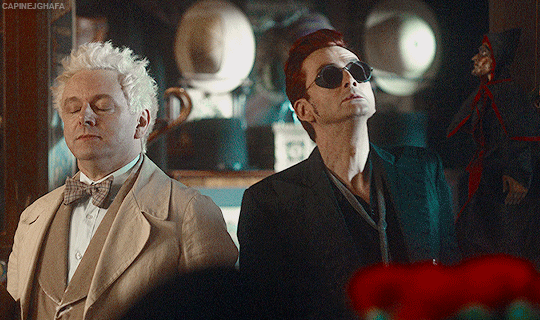
I wrote a post awhile back about how I think one of the reasons why Aziraphale keeps a journal is as a way of having something that Crowley can show to him in the event that Heaven takes his memories. While reading something doesn't necessarily trigger a memory itself-- it can but it's not guaranteed-- I think there might be other things they are doing as well that they think might be effective in different ways when it comes to helping Aziraphale retain his memory. The biggest might be actively trying to create for the future what are known as madeleine memories or involuntary memories.
Understanding of involuntary memory? It comes from the extremely Aziraphale intersection of food, the French, literature and psychology...
For anyone who does not already know about involuntary memory:
In 1913, French writer Marcel Proust published the first volume in his 'In Search of Lost Time' series and it contained a passage about the power of memory so descriptive and that resonated with so many that it got scientists to actually study and prove the validity of the connection between scent and memory about which he wrote. Proust had his narrator in the novel describe how, after dipping a lime madeleine into a pot of tea, the scent and taste of eating the madeleine brought him instantly back to a specific time in his youth when his aunt would serve them to him while he was recovering from illness as a boy. He remembered details about her house and their time together, sounds and scenes that had dimmed or been forgotten entirely... all triggered by his mind upon smelling and tasting the specific combination of flavors of the tea-dipped lime madeleine.
Most of us have probably experienced something like this and scientists have since confirmed that it's a very real phenomenon, probably rooted in our need to be able to recognize danger by scent. They have also found that, in some cases and to a slightly lesser degree, hearing specific pieces of music can also bring about a similar sense of memory. Scent, though, remains the best possible trigger for memory.
I can't imagine that after seeing Crowley struggle with his own memory for so long and knowing that it could happen to him, too, that Aziraphale wouldn't be trying everything he could think of to be prepared for the possibility that it might.
In a story that has so much focus on memory-- and in a way that seems to potentially foreshadow that Aziraphale might (temporarily) lose his before the story is over-- there also are scenes that might suggest that Aziraphale's mindful moments might also be an attempt at trying to associate moments with scent in an effort to get around Heaven and retain as much of his memory as he can in the future.
But that's only one part of it... The other part is how he and Crowley are shown to consistently tie times in the present to times in their past.


There are many reasons for doing so and we looked at some of them in other metas but another one might be as a way of trying to connect memories together in a way that, should Aziraphale lose his memories in the future, if one could be triggered with a madeleine memory, then other memories connected to it might follow.
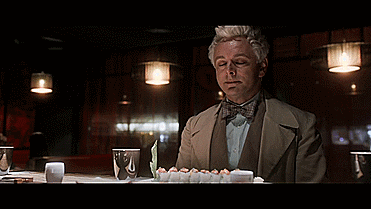
In the first episode, Aziraphale's mindful, sensual eating experience involves breathing in the scent of the sushi with his eyes closed, as if committing it to memory. The evening, as we looked at in the Fish meta, was supposed to be a dinner with Crowley tied to their time in ancient Rome. Breathing in brine and alcohol and salt like Aziraphale is here might also be a way of trying to literally tie these scents to his memories of the scents of oysters and wine in Rome so as to not forget either.
In the parallel to the sushi scene in 1.01, Aziraphale is shown in S2 to breathe in Goldstone's when he and Crowley go there in the present. It's part of the mindful experience for him in the moment but it could also serve as a way of trying to remember the events of both the present and 1941 in the future.

Crowley also breathes in Goldstone's in the present in S2. It's something they both do without even looking at one another in the scene and just kind of know the other is, indicating that this is just a thing they do. Both of them do it instinctively, like the rampant sensualists using elements of mindfulness to work through trauma that they are lol. Aziraphale's eyes are again closed and I would bet that he's as much willing himself to never fully forget his human magic love and 1941 in the future as he is reliving memories of the past.
This scene is a really interesting inclusion because while it's set in our present of S2, it's really about the past and the future. No one has any trouble believing that they're both thinking of 1941 here, even as they're here in the present, and both of them are utilizing techniques both related to the present (mindfulness) to connect with memories of the past (Proust Effect/involuntary memory.) What else might be true as well is that they don't just do this for the past and the present moments but for potential future ones as well.
Then there's this...

There are two scenes-- one in each season-- that focus on Crowley's unsurprisingly amazing scent. While memory wouldn't be the only reason why Crowley would smell great lol, both scenes suggest that Crowley's scent is unique and distinguishable. Sandalphon can smell it as being different from Aziraphale's cologne in S1 and Shax... a paralleling character to Aziraphale, played by the actress who played the character with whom Aziraphale shared a brain in S1... well, Shax is into it. Girl's in a dead faint to a point of straight up huffing him.
While there are others, one reason for this scene, though, could be that it parallels the fact that Aziraphale actually does this sometimes, if in a decidedly less ick way than Shax did lol. Part of why Crowley's been wearing the same, apparently quite appealing, scent for awhile now could be out of an effort to help Aziraphale's mind create enough associations between Crowley's scent and Aziraphale's memories that Crowley himself might be able to trigger some of Aziraphale's memories just by his presence alone.
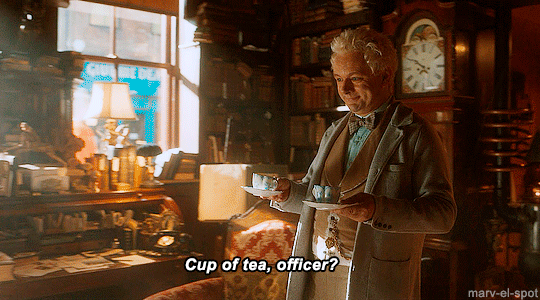
It's also then interesting-- and potentially a little eerie-- that the only time Aziraphale eats or drinks anything in the present in S2 is when he drinks a few sips of a cup of tea to introduce Muriel to the drink and the custom. This is just after Muriel showed up at the door and failed to recognize Aziraphale, even though he recognized them, in one of several scenes that suggest that Muriel had their memories taken from them at some point. The two characters parallel one another pretty strongly. The difference could well wind up becoming that Aziraphale is able to retain more of his memories because he and Crowley have been working for years to find ways to get around Heaven... and they're using knowledge uncovered by humans to save what they can of Aziraphale's memories.
Or, as Nina would put it:
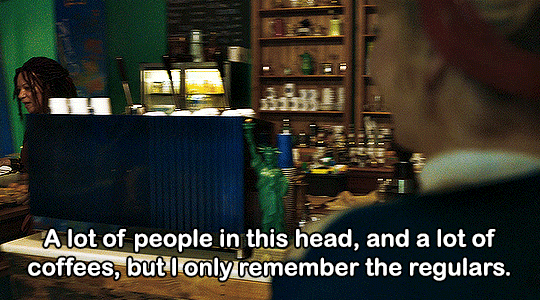
#ineffable husbands#good omens#crowley#aziraphale#aziracrow#good omens 2#good omens meta#good omens theory#crowley x aziraphale
163 notes
·
View notes
Text
Ranking 2024 anime, Pt. 1: Movies, specials, and #43-41
hey, this post is also available on my ko-fi, so please check it out and consider tipping/donating as i do this for free and am currently between jobs. thanks!
Hey, y'all. Starting a little later than usual this year but I've been busy this time of year, not the least of which with The People's The Game Awards, which will be streaming here on Dec. 31!
But now it's time to promote the output that's entirely mine. I watched even more anime in 2024 than the prior year, somehow, and it's time to rank it. Because I was reviewing these series at the end of their respective seasons, I won't be going quite as in depth on the shows I'd already covered from January through September. There will be full reviews for the stuff I just watched in the Fall season, as well as this first section here, as part of the rankings.
As always, this is entirely a labor of love, so subscriptions and donations would be hugely appreciated, and I could really use them right now.
So first, let's start with:
Movies and Specials

Look Back
There weren’t many things I was looking forward to this year quite as much as this movie’s western release. Based on one of a trio of one-shots Tatsuki Fujimoto published during Chainsaw Man’s hiatus, Look Back is a short but potent story about art and manga, the highs and lows of the creative process, and the connection between two young artists putting their heads and hearts together.
The story follows Ayumu Fujino (definitely not an author self-insert), a fourth-grader who draws short comics for her school’s newspaper. She’s mortified when she’s asked to make space for another strip by an absentee student who turns out to be a much better artist than herself (again, definitely not a self-insert for a mangaka who has publicly described his self-consciousness about his artistic talents), and even after years of further studying and practicing, Fujino feels so completely outpaced by the other, Kyomoto (also not a self-insert), that she quits. At the end of the school year, though, Fujino is talked into dropping something off at Kyomoto’s house, where she learns that the latter was a huge fan of her work and was disappointed to learn that she’d quit, and they decide to team up and make manga together. The successful one-shots they publish throughout middle and high school eventually prompt a Shueisha editor to approach them for serialization, but a rift starts to form.
Look Back and by extension plenty of Fujimoto’s works can be hard to talk about because they say so much for themselves with only so many words. The manga is a brief but potent masterpiece, and the film adaptation by Kiyotaka Oshiyama (director of Flip Flappers and key animator with credits in Devilman Crybaby, Mob Psycho 100, and recent Miyazaki films) is very much the same in its own right. This adaptation retains much of the feel of Fujimoto’s art and perfectly delivers the emotional beats of the story, while adding some flair of its own. The amateurish 4-koma that define our young artists’ early careers are given a low-fidelity animatic treatment to match, while the real-life action is animated fluidly and realistically. Haruka Nakamura’s gorgeous score punctuates and elevates Look Back’s emotional highs and lows with delicate piano and lush strings that only draw you deeper into this beautiful story. There are even references to the mangaka’s other works peppered throughout the film.
The most distinctive trait of Tatsuki Fujimoto’s manga is his expressive and creative use of paneling, often used to wordlessly display changes in expression or the passage of time in the same way a storyboarder would. Conceptually, this would translate well to film, and although Look Back is a phenomenal film in its own right and captures much of the feel of its source material, it’s not exactly the same. And honestly, that’s a good thing. If it’s worth recommending both works in equal measure, then both were successful, and that’s the case here.
In a featurette that was shown after theatrical screenings, Oshiyama was very outspoken about infusing realism into the production, despite the story’s climax veering into magical realism. What he wanted wasn’t a realistic look or feel to the film itself, but in the production thereof: The leads are voiced in Japanese by complete newcomers (who do an incredible job) and plenty of the film’s line art, especially in its tearjerking denouement, can look intentionally unrefined. Oshiyama has made it clear that he wanted Look Back to come across as much like a handmade product as possible, specifically because it released into an age where the existence of generative AI is posed to threaten the livelihoods of entire creative industries.
Even if I hadn’t seen the film, I’d have known just from his comments that Oshiyama understood the assignment. Look Back is a story about creativity and creation, warts and all, and what is so innately human about it: The parts of ourselves we put on the page or screen, which of our shortcomings we can improve on our own and which ones we overcome with the contributions of others, and the connections we make throughout. Tatsuki Fujimoto is a master mangaka, and this film is a perfect companion piece to a true work of art.
Watch this movie.
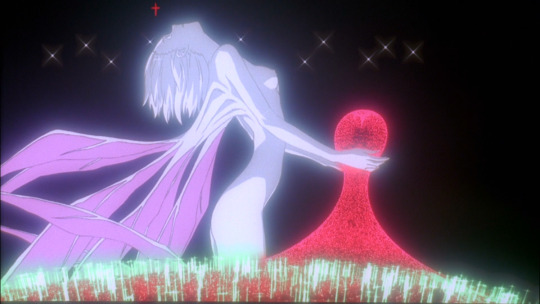
Neon Genesis Evangelion: The End of Evangelion
I’m not usually the type who includes older media in “best of the year” discussions, and certainly not media that’s nearly 30 years old, but The End of Evangelion is one of my favorite movies ever. Full stop. Regardless of how many times I’ve watched and rewatched it in my adult life, I leapt instantly at the opportunity to see it in its first American theatrical run so many years after its release.
Decades’ worth of ink has been spilled over this film and its meaning, themes and intentions. It is a prism through which no two people may see the same thing: Many have interpreted The End of Evangelion as an angry, hateful work by a creator who wanted nothing more than to spite his fans, and others have venerated it as a message of hope, that a better world is possible as long as you put the work in. I have too many other things to write about to do a proper dive into what this movie means, or more specifically what it means to me. I’ve put it here because the experience of seeing it in a packed theater was immensely satisfying.
To be surrounded by so many people while taking in something so important to me was exhilarating. The increasing laughter as more and more production tags flew across the screen in the first minute and a half felt like a community being established. Fortunately, that was most of the noise I’d heard. Not that I was expecting a “Komm, süsser Tod” singalong or anything, but I’m thankful that the audience was mostly quiet otherwise, because the change of venue from my usual viewing environs of a desk or couch was transformative and I would not have been happy if anything had distracted from that.
There are too many iconic moments in The End of Evangelion to name, several of which you’ve probably seen even if you don’t know Evangelion that well, and they looked absurdly good on the big screen. Asuka’s fight against the Eva series remains some of the best action animation I’ve ever seen in my life, and it held up. The inception of Third Impact and all of the iconic images that came from that sequence were visually arresting, and I don’t say so lightly: I legitimately felt overwhelmed at several of these moments. Someone a seat or two over from me was stifling tears towards the end, and I don’t blame them one bit, crybaby that I am. But by the final scene on the beach, a scene whose coda in 3.0+1.0 never failed to reduce me to a blubbering mess, I couldn’t even process emotion anymore. Seeing something this familiar, this meaningful to me, in such an all-encompassing environment, shorted my brain for a second. I was stunned, eyes bugged and mouth agape, like something had touched my soul directly. And just like my first viewing of this film, part of me was forever changed.
The first time I’d seen The End of Evangelion did not come at a great time in my life, and if I’m being honest, I wasn’t doing too hot when I saw it in the theater this year either. But, in ways I’m not sure I can elaborate, I think they came at times when I needed them. Evangelion remains a major marketing machine some three decades after its debut, but sometimes it’s still just something you need to take in when you’re going through it. I’m glad I did. If you have a favorite anime film that manages to make its way back into theaters, I cannot emphasize enough how wonderful it feels to actually go and see it. I wish I’d done the same with the Gurren Lagann films when they came back.
I just wish Gkids hadn’t used the Netflix subtitles. The first scene just doesn’t hit the same without “I’m so fucked up.”
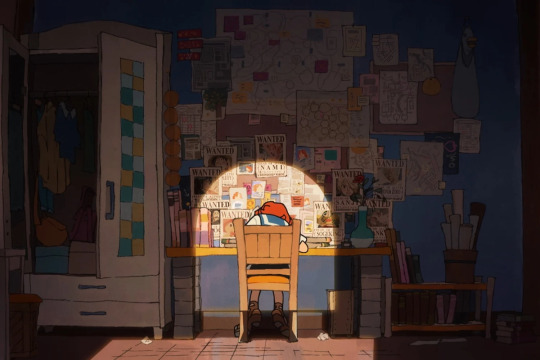
One Piece Fan Letter
For all of the anime I’m covering at year’s end, I think the most important thing about my 2024 in anime and manga, after hemming and hawing about it for so long, is that this is the year I finally got into One Piece (the manga, not the anime). And just as I’d expected, it required a massive investment of my time, but it paid dividends and continues to do so as the story creeps ever closer to its eventual conclusion.
The manga is phenomenal, but the anime would’ve been a much larger time sink, so I haven’t really bothered (the live action series is great though). I’ve watched a small handful of episodes and clips of the more important moments, and took in a bit of the anime’s current arc before it went on hiatus. It’s come a long way from how it looked 25 years ago and I’m genuinely impressed that a weekly anime can exhibit such a high budget and wealth of animation talent, but I don’t really have it in me to trudge my way back to the start of the Wano arc and watch nearly 200 episodes of just that.
What I did have time for, and only 24 minutes of it at that, was One Piece Fan Letter, an episode-length special loosely based on the Straw Hat Stories novel. Fan Letter takes place around the end of the timeskip as the Straw Hat crew make their reunion in Sabaody, but it doesn’t focus on the crew themselves; we instead spend our time with a handful of regular people living their lives on the archipelago. In a way, they’re a lot like us: they’re all fans of the Straw Hats, and each one has a favorite. A Marine goes against code and secretly looks up to Luffy for giving him the courage to save his brother’s life. A shopkeeper bemoans missing Brook’s last show as Soul King. Some rowdy Marines have a drunken powerscaling argument not unlike one you’d see on Twitter any given day.
Front and center, though, is a young girl who looks up to Nami. She dresses like East Blue-era Nami, avoids wearing glasses in order to look like her, and even has the red hair to match. She’s managed to decode Luffy’s reunion message (in a comically roundabout way) and sets out to hand-deliver her message to Nami before the Thousand Sunny sets sail again, but she finds herself hampered by several distractions and obstacles, largely thanks to the Straw Hats and those in their orbit.
Fan Letter is a short but sweet story that mirrors our own fandom of the series and its characters in the lives of everyday people along the Grand Line. A huge part of what makes One Piece work as an ongoing saga is seeing how Luffy and the Straw Hats’ escapades and freedom fights materially benefit the people of each island they visit and, if necessary, liberate. And not that the series isn’t long enough, but something we often miss is how the crew’s efforts affect the people they don’t interact with on some level (Usopp does briefly help direct our protagonist here, but she never finds out it’s him). Fan Letter focuses more on the emotional impact the Straw Hats’ heroism leaves on the regular folk and even the Marines that are meant to oppose them.
Though creator Eiichiro Oda had no hand in Fan Letter, I think it focuses on one of his major aims in writing One Piece: For all its silliness, spectacle, and hype, it’s ultimately a story of people helping and improving one another’s lives en route to attaining their dreams, and it’s meant to inspire us to want to do the same. Fan Letter puts these intentions in stark relief by showing us not only how the Straw Hats have inspired people on and around Sabaody, but also those same people trying to return the favor in whatever small way they can. Those in lesser positions might write a letter or turn out for their favorite artist, while those in positions of power can literally save lives. If someone has made your life better in any meaningful way, you are always in a position to thank them or pay it forward.
As with just about everything attached to One Piece nowadays, Fan Letter looks phenomenal. Everything has a loose, kinetic quality befitting Luffy’s rubbery nature, and the breakneck composition and sequencing of shots makes every second of the short runtime count. If you’ve been on the fence about One Piece, it’s at least a quick curiosity that might pique your interest. To longtime fans, though, Fan Letter is an essential piece of the puzzle.

Spy x Family Code: White
After a certain point, I’m having trouble writing about any new Spy x Family entries because, like, it’s more Spy x Family. If you’re already here, you know what you’re going to get. There’s gonna be silly misunderstandings, Anya’s gonna be cute, Yor’s gonna do some sick action moves, and you’re gonna have a great time.
Code: White is a self-contained film with an original story by creator Tatsuya Endo, so continuity isn’t a factor here if you’re worried about canon. The Forgers take a vacation to the alps to help Anya with a school project, Yor misinterprets Loid’s secretive nature as a sign that he’s cheating on her, and Anya unknowingly eats a bonbon containing a microfilm that would help turn the cold war hot. We get our cozy moments, our silly moments, and our fun action setpieces towards the end. Again, it’s more Spy x Family and that’s what you’re here for.
I know this sounds dismissive, but you already know what you’re getting into here. And I want to be clear that it’s still really good! It’s cute, it’s funny, it’s exciting, and everything and everyone looks and sounds great. There’s a sequence where Anya has to poop so badly she starts hallucinating. It’s great stuff. Essential viewing if you’re a fan.
And now, let's get on with:
Ranking Every New Anime I Watched in 2024

43. The Unwanted Undead Adventurer
I didn’t want to talk about this show when I reluctantly finished it nine months ago and I don’t want to talk about it now. Maybe not the worst anime I watched this year but certainly the dullest. Ugly, slow, and boring is no way to entice me into watching a second season. Pass.
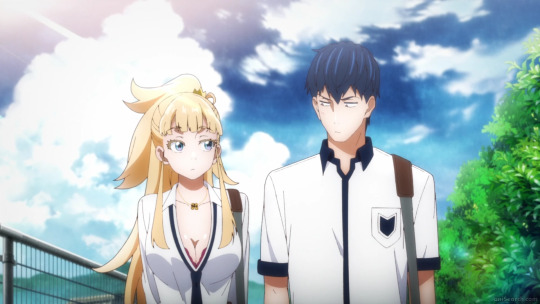
42. Tales of Wedding Rings
This somehow ended up being the only show that I picked back up this year, including the ones I initially liked. I was pretty blunt about what I didn’t like about Tales of Wedding Rings back in March, from its waifu-of-the-week format to its formulaic wheel-spinning on the main romantic pairing to its hideous aesthetic and poor animation. It had already been confirmed for a second season and I’d had no interest in finishing the first.
But against my better judgment, I decided to take some time reading the manga around the time it came to an end later on in the year and ended up liking it a decent amount. The manga looks way better, for one thing, and all of the more interesting plot elements manage to intensify and coalesce. Between the standard isekai slay-the-demon-king plot, the “will they/won’t they” tension between the romantic leads, and yes, the overt horniness of everything else, the first season really was just table setting for a story that does in fact get more interesting and worth spending time with. So, armed with knowledge of the next story beats and a more open mind, I went back and dusted off the three episodes I’d dropped back in March.
And I still can’t stand this show.
Tales of Wedding Rings is still one of the ugliest anime I’ve ever seen in my life. The color palette is weirdly muted and everything is overlit and gauzy. Line art looks brittle and cheap. You could try to make the excuse that a show with so much nudity wasn’t going to earn a high production value, but that excuse falls flat when you remember that it aired alongside well-produced (if maybe questionable) uncensored series like Chained Soldier and Gushing Over Magical Girls). Like I said earlier this year, if you present me with full-on elf tits and still can’t make me care, you’ve failed. I didn’t watch Plus-Sized Elf for the exact same reason. I learned my lesson.
I really try not to judge the entirety of a show by how it looks, but my eyes can only take so much. I can only hope the second season looks better, lest I have to Ludovico myself into continuing with the series.
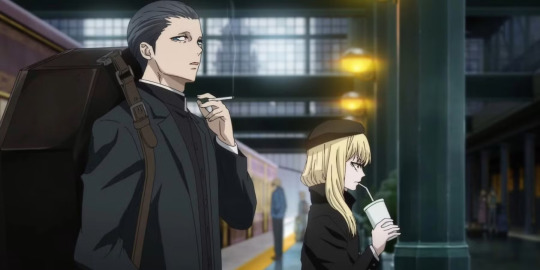
41. The Witch and the Beast
I was really looking forward to this one. The quasi-gothic/steampunk aesthetic is absolutely not my shit on paper but it looked awesome in execution… at first. After just two episodes, though, The Witch and the Beast looked like too ambitious and detailed a project for its animators to handle and it started looking cheap in record time. Character models were inconsistent to the point of being unrecognizable, animation was often stilted, and lighting and color palettes were dull. Didn’t help that the action died down for a good chunk of the season as well, leaving us with a show that was both ugly AND boring.
Nine months later and there’s still no word on a second season, and I can’t say I’m surprised. It didn’t seem to accrue much popularity, and I struggle to think what would’ve helped aside from the issues I just bitched about. There was a tease of more to come at the end, right on the heels of a massive lore dump that seemed to open up the world to a much larger scale. That could be interesting, but I don’t think I’d want to watch any more of The Witch and the Beast. Maybe I’ll bite the bullet and finally read the manga.
59 notes
·
View notes
Text
Glad to see that Tim being a giant Dick Grayson fanboy is finally being highlighted again, and sparking more discussion especially on their early relationship! (Please gimme more!!! I love them so much, augh!)
Probably as a result of that surge, there seems to be reciprocal chatter on the topic of how young Tim actually felt towards Jason, too. It's honestly pretty interesting, because it's more nuanced than it appears at first glance.
Which means it's very fun to dissect! ✨
There's a degree of subjectivity to keep in mind, because readers are going to have different interpretations of the same scenes, or will pull from entirely different scenes than one another to form their individual view on this topic. That's just how it is in comic book fandom, for many things! Regardless, in this case... if the scale ranges from the extreme of "Jason was Tim's Robin" to the other extreme of "Tim actually hated Jason [as Robin] or thought he was a loser that got himself killed" — the actual truth is closer to the middle, as is often the case.
At least, in my opinion.
Mainly I want to focus on those relatively early days with this post, to highlight Tim's initial(-ish) feelings towards his heroes, and touch on the point at which they really begin to change. This turned into a very long post, though. Brevity is beyond my skill, so grab snacks and water lol. Transcripts for each image will be posted at the very end under the cut.
So, the two storylines I want to cover are "Rite of Passage," which is rolls into "Identity Crisis." (NOT to be confused with the major crossover event "Identity Crisis™" which came years later, and is where Jack Drake dies.... But it sure is an interesting coincidence that Tim deals with the loss of each parent in two similarly named stories!) These take place before Tim is even Robin, and I'll be considering them as one arc for this post.
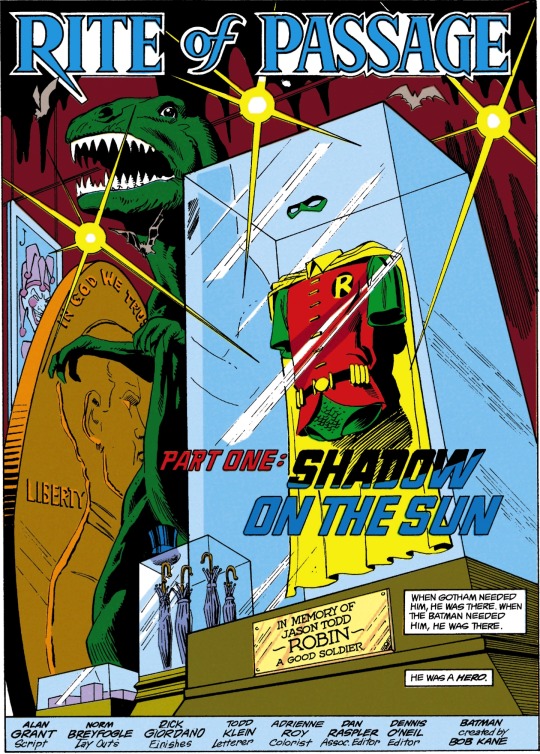
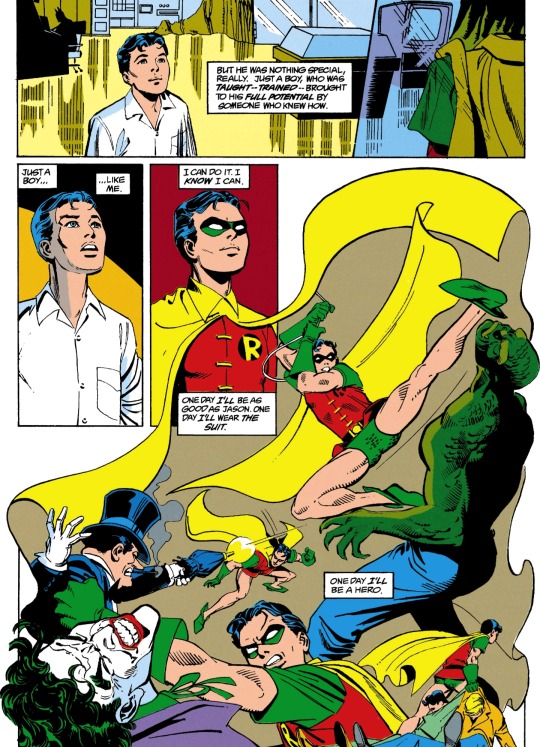
Detective Comics vol. 1 #618 (July, 1990) -- Pages 1 & 2
"When Gotham needed him, he was there. When the Batman needed him, he was there. He was a hero."
"One day, I'll be as good as Jason. One day I'll wear the suit."
To start off, we have this opening from "Rite of Passage." Tim is still in training here, mainly helping Bruce with minor stuff from the cave. His parents are off traveling, alive and well as of these next few pages. He's still bright-eyed and full of wonder. An extraordinarily weird but ultimately innocent kid.
So his view on Jason is positive and fairly simple: a hero, and someone to look up to as Robin. Clearly, Tim here doesn't think Jason was deficient in his role, either as a protector of Gotham or as Batman's trusted partner.
Moreover, Tim already held Dick in very high regard because he was amazingly skilled before he became Robin. To Tim, that's not something he'll ever be able to achieve. Meanwhile, Jason wasn't like that. He was a regular kid without crazy acrobatic training since practically birth. Yet he still went on to be a hero—which is obviously motivational for Tim who finds himself in similar shoes.
It's true that Tim only ever knew or thought of Jason as Robin, and idolized him in that regard. But that's kind of all that mattered to him at that point, because he was this kid who was utterly star-struck by his heroes. Even if he's technically aware of their shortcomings as people, it's overshadowed by the hero-worship.
It was kind of the same with Bruce as Batman at first. (Which was still enough for Tim to risk life and limb to help his beloved hero, before Bruce even knew his name.) Dick was the only one Tim had any sort of "personal" relationship with beforehand, so there is an extra level of attachment—and hence why it was the nidus for his obsession with Batman. Yet even then, it wasn't like he actually knew anything about Dick as a person until later. Until then, Tim's ideas of him were all he had, too. With Jason, Tim just didn't get to know him at any point before his return (oof), apart from what he heard over the years secondhand (also oof).
Ultimately, it's the loss of innocence—along with the ricocheting bullet that is the unresolved guilt of those around him—that begins to change Tim's perception. Not just of Jason, but of things in general.
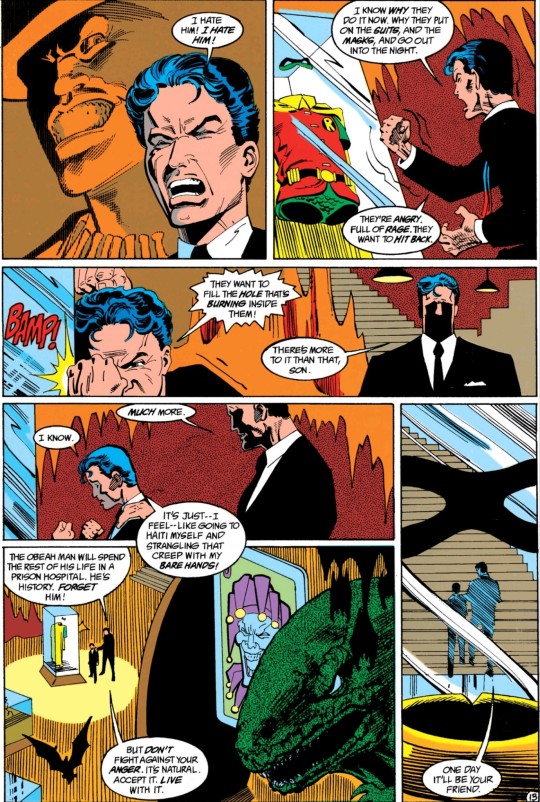
Batman vol. 1 #455 (Oct., 1990) -- Page 13
"I know why they do it now. Why they put on the suits, and the masks, and go out into the night. They're angry, they're full of rage. They want to hit back."
Losing his mother was a major shift for Tim, obviously. This is right after the previous storyline, and Tim's had the worst week or two of his life (so far). His monologue here is a reference to what happened to both Dick and Jason. The unbearable pain of loss, the rage masking the grief underneath. And importantly, that he feels both of them were justified in their anger. (And Bruce too, indirectly.)
The major theme of the aptly named "Identity Crisis" is to mirror aspects of Dick and Jason and Tim's lives—to show how they converged onto the same tragic road. It's something that Tim notices early in the story, and was frightened by. Now, horrifically, it's become a part of him as well. His parents are gone, and he was entirely helpless to do anything about it. Dick was the same way, Jason was the same way. The cycle is repeated.
In particular, the part about him wanting to go to Haiti for revenge—for his mother—sort of struck me as being an intentional parallel to Jason and Ethiopia. It's a bit of a stretch, especially in isolation, so others may see it differently (e.g. the angry ramblings of a grieving child that does sound like something anyone might say). But it always stuck out to me because of how much Tim is compared directly to Jason in this arc. More on that below.
It's not something I can really give an accurate feel of because it's a lot of subtle things that begin to add up, so I'd encourage folks to read this arc themselves to see what I mean. (Or maybe you'll still disagree which is fine too lol.) Again, many things are in reference to both Dick and Jason in relation to Tim, but it's weighted more on Jason's side.

Batman vol. 1 #455 (Oct., 1990) -- Page 18
"You think my anger will boil over, the way Jason's did. I can assure you, it won't!"
Tim's grief has begun to pull away the veil of idealism that enshrouded his heroes in his mind. It doesn't apply only to Jason, but to the rest of them. Plus add the fact that Tim's keenly aware that he's being managed, even if the adults around him are careful to not outright say certain things. He still knows.
Bruce, Dick, and Alfred are all worried about Tim potentially turning into "another Jason." They (and mainly Bruce) caution Tim to not ignore his emotions, but they're still concerned that he may be overly eager to prove himself in order to cope, and could get hurt or killed as a result. While they aren't wrong for their caution—especially at how unsettlingly similar all the circumstances are—they aren't very subtle about the elephant in the room.
Imagine how that would affect Tim's perception of his predecessor, especially when he's in the midst of a traumatic event he hasn't had time to fully process. The negative association is pretty much inevitable.
Tim's known from day one that he's walking in Jason's shadow, and now it's become inescapable. Tim went from seeing Jason as a goal to reach, to feeling that unless he surpasses him, he wasn't going to be taken seriously by anyone. However, as of this arc, Tim doesn't even fully come to that point yet.


Batman vol. 1 #456 (Nov., 1990) -- Pages 14 & 15
"Drop-outs don't make it. And dead heroes are no use to anyone!"
It's really easy to take away "Tim totally thought Jason got himself killed" as the main thing here, but I think that's missing the forest for the trees.
First some context: Bruce has gone out on a mission to get Scarecrow, and expressly forbade Tim from doing any shenanigans. Meanwhile, Tim is grappling with wanting to prove himself and trying to help Bruce from the cave, all while trying to deal with his emotions. At some point, he falls asleep and ends up having like... exhaustion-grief hallucinations of Dick!Robin and Jason!Robin who confusingly caution yet encourage him. The main theme of this part is facing your fears.
Depending on how you want to interpret the intent of Jason's dialogue here, you could go several ways with it. Ranging from "writer's feelings towards Jason" to "a peek into Tim's mind as his fears manifest as visions of his heroes" or some mixture thereof.
Though Tim argues with Bruce that Batman needs a Robin, we're shown that Tim is understandably scared of joining Batman's "war." He's still not willing to let Bruce go it alone, though, and that's something he feels more strongly than his fear.
Meanwhile, hallucination!Jason's warnings are a lamentation of what happened to him in a way, but it actually exactly describes Tim's current situation even more so. Unlike Jason, Tim is under-trained, under-experienced, doesn't even have a suit of his own yet. But like Jason, he can't sit by and do nothing while someone he cares about is in danger. Tim knows that if he goes out there, he will probably get himself killed, and it will be his own fault. So he's about to disobey Batman's orders, and fly right into danger. If that got Jason killed, then Tim—who is in a way worse position experience-wise—has every chance of ending up the same.
Like... it's about Jason, but it's also about Tim. It's Tim's worst fears made manifest, via the representation of why he is even here in the first place (Jason's death).
That's my theory anyway, but perhaps this is an overly charitable reading of this scene on my end. (Not that I think that makes me wrong lol.) However given that Grant wrote both parts of this arc, and the beginning of which is especially favorable towards Jason, it certainly is something to ponder. I have a lot of thoughts on it I can't expand on here tbh but perhaps that'll be another post.
Anyway, returning to the point of the similarities vs differences between Tim and Jason: since this is the arc that solidified Tim as the next Robin in comic continuity, it makes sense that the writers really pushed the comparisons between the two of them, specifically. (Even though Dick was pretty similar, as going against Batman's orders is the Robin thing to do, it's not his shoes Tim is directly filling.) So making Tim's "debut" story arc mirror Jason's "swansong" is an obvious narrative choice.
To drive home the parallels, I wanted to include this panel from just a few pages prior to the "daydream":
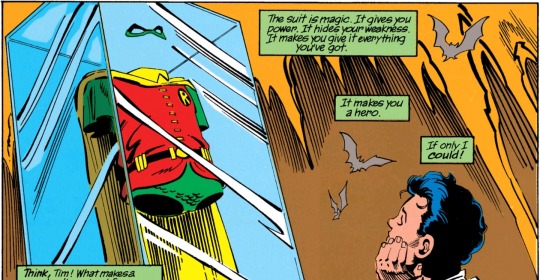
Batman vol. 1 #456 (Nov., 1990) -- Page 9
"The suit is magic."
That so distressingly close to Jason's famous "being Robin gives me magic" line (Batman #385, page 6). Given all the previous context, it's hard for me to just dismiss it as pure coincidence. Even if it is, the point still stands. Tim is shown having the some of the same heartbreakingly naive views as Jason once did, right in front of Jason's memorial, just as he's about to go and run off into the night against orders.
I think that speaks for itself. There's a lot to take away from it, if you so choose. Especially given the context of that specific Jason arc.
Alright, back to the main course:
So in the end, Tim actually goes out in civvies and a ski mask because if he fails, then at least he wouldn't bring shame to Robin's legacy™. When he gets fear gassed saving Batman, it's once again both Dick and Jason that he hallucinates encouraging him to push past his fear. (Shout out to the fact that he's literally more afraid of tarnishing the legacy of Batman & Robin than he is of dying.... I'm sure this will not be a recurring thing for him in the future.)
Tim's ideology is shown to be similar to Jason's, and the actions Tim ultimately takes are similar to Jason's... but the outcome is different. And it really isn't just "Tim succeeded where Jason failed." At least, that's not what I took away from this. Rather, Tim had no reason to succeed any more than he had to fail, just that he did. Luck combined with caution because he knew what happened to his predecessor, and the fact that Batman was there to finish the job all made the difference.
You could say (and I know some will) that it's just classic Jason character assassination and the writers trying to implore readers that this new kid is different we promise pls don't hate us look how much better he is! But in this case, that feels like it undermines the whole point of this story. It doesn't fit with what the characters actually say.
Thus, we return to the question of how Tim felt towards his predecessor. And the answer is different from where we started, because Tim is different. Not that different though. Because even though at this point Tim—like all the adults around him—has probably attributed Jason "going off on his own" being what led to his death, Tim still thought of him as a hero to look up to. It's about Robin, first and foremost, yes. But Tim is fully aware of the people who made that suit mean what it does, because it's all intertwined.
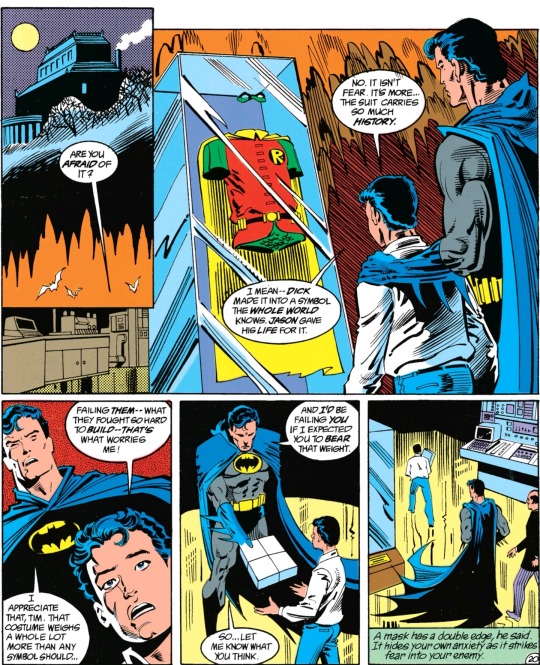
Batman vol. 1 #457 (Dec., 1990) -- Page 20
"I mean--Dick made it into a symbol the whole world knows. Jason gave his life for it."
Even further, Tim thinks of it in terms of Jason having given his life for what he believed in, for the legacy that now falls to Tim. There's a sense of gravitas there. He's afraid of failing both the Robins who came before him.
Ultimately do I think Tim adored and loved Jason on the same level as Dick or something? No. It's not comparable. (Dick was like part of some of Tim's earliest memories and everything! They have a really unique bond ok.) Yet Tim was also far from thinking poorly of Jason so early on. Frankly, it seems that Tim thought of Jason as a noble hero and a cautionary tale. Yes he took risks and sometimes went too far, generally stuff that Tim doesn't want to repeat and all that. At the same time, Tim still saw him as someone whose legacy and memory was worth honoring.
It's complicated, which is why I like it so much—because it feels real. Having conflicting feelings towards someone is... so human. Especially someone you never got to know, yet who plays such an integral role in your life via the shadow of their death. How can you feel anything but complicated towards them?
It has to be said that, yes, Tim's views—even before Jason's return—change over the years. He becomes more jaded as a person and is surrounded by people who are even more jaded than him... and who often mention Jason as the "failed Robin." It's something that's hung over Tim's head all the damn time. The curse of the Robin mantle.
So it shouldn't come as a surprise that Tim's idea of him becomes more akin to "sounds like a skill issue" as the years go by. All bets are off after Jason's return, and the Titans Tower Incident™. At that point it's firmly "I am better than you, loser" lmao.
And... that's all without getting too into things like authorial intent and general "moods" of different DC writers towards Jason at a given point. Or retcons that played a role in his characterization and how other characters talk about him, depending on what "era" you're reading. That's way beyond the scope of this post though!
TLDR; even though young Tim Drake was obsessed with Dick Grayson as Robin, he still looked up to Jason Todd as well. He didn't think of Jason as a cringefail loser until later. :)
(image dialogue transcripts under cut ↓)
Dialogue Transcript for Image 1 (Detective Comics vol. 1 #618 -- Page 1):
Narration box (Tim): When Gotham needed him, he was there. When the Batman needed him, he was there. He was a hero.
Dialogue Transcript for Image 2 (Detective Comics vol. 1 #618 -- Page 2):
(Scene continued from previous page)
Narration box: But he was nothing special, really. Just a boy, who was taught--trained--brought to his full potential by someone who knew how. Just a boy... like me. I know I can do it. I know I can. One day I'll be as good as Jason. One day I'll wear the suit. One day I'll be a hero.
Dialogue Transcript for Image 3 (Batman vol. 1 #455 -- Page 13):
Tim: I hate him! I hate him! I know why they do it now. Why they put on the suits, and the masks, and go out into the night. They're angry. Full of rage. They want to hit back. They want to fill the hole that's burning inside them.
Bruce: There's more to it than that, son. Much more.
Tim: I know. It's just--I feel--like going to Haiti myself and strangling that creep with my bare hands!
Bruce: The Obeah Man will spend the rest of his life in a prison hospital. He's history. Forget him! But don't fight against your anger. It's natural. Accept it. Live with it. One day it'll be your friend.
Dialogue Transcript for Image 4 (Batman vol. 1 #455 -- Panels from page 18):
Tim: Because you think my mother's death has upset me too much. Well, it did. But I've taken your words to heart. I can cope. You think my anger will boil over, the way Jason's did. I can assure you, it won't. But that doesn't make any difference, does it? Why can't you have a little faith in me?
Dialogue Transcript for Image 5 (Batman vol. 1 #456 -- Page 14):
Narration box (Tim): Blast it! My head's starting to swim. I'm about ready to give up. I almost wish I'd never heard of Batman and Robin!
Vision Dick: Heroes never give up, Tim.
Vision Jason: You know that.
Tim: Dick--! Jason Todd!
Vision Dick: You're training to fight in a war, Tim. It'll last all your life. No matter what, you have to go on fighting.
Vision Jason: Drop-outs don't make it. And dead heroes are no use to anyone! I thought I knew better than Batman. I thought I could run before I could walk. I killed myself, Tim. Because I couldn't wait. Because I couldn't think it through.
Dialogue Transcript for Image 6 (Batman vol. 1 #456 -- Page 15):
(Scene continued from previous page)
Vision Dick: Think, Tim. Concentrate!
Vision Jason: You can do it.
Both: You can do it!
Tim, waking up: What--? Robin...?
Narration box (Tim): I must have been daydreaming. They're right, though. There's a solution to everything. I can find it! So here I go again... Whim. Caprice. Doing something without forethought.
Dialogue Transcript for Image 7 (Batman vol. 1 #456 -- Panel from page 9):
Narration box (Tim): The suit is magic. It gives you power. It hides your weakness. It makes you give it everything you've got. It makes you a hero. If only I could!
Dialogue Transcript for Image 8 (Batman vol. 1 #457 -- Page 20):
Bruce: Are you afraid of it?
Tim: No. It isn't fear. It's more... the suit carries so much history. I mean--Dick made it into a symbol the whole world knows. Jason gave his life for it. Failing them--what they fought so hard to build--that's what worries me!
Bruce: I appreciate that, Tim. That costume weighs a whole lot more than any symbol should... and I'd be failing you if I expected you to bear that weight. So... let me know what you think.
Narration box: A mask has a double edged, he said. It hides your own anxiety as it strikes fear into your enemy.
#tim drake#jason todd#dcu#dc comcis#batfamily#meta#I'm so sorry this post got out of hand fr#it was meant to be a quick drabble with some comic panels and instead i just...... kept going#this post is specifically for my one (1) bestie who cares and the like 2 ppl who might be as insane as me about Timmy#idk why I'm like this im just obsessed with Tim's relationship with early Batfam & co lately???#late 80 and early 90s comics my beloveds......#anyway if this gets more than 5 notes i'll be shocked and scared lol#nyerus.txt#text post#long post
609 notes
·
View notes
Text
the root chakra and whether i believe you could survive an apocalypse
the root chakra is telling of our survival instincts and what we need to survive.
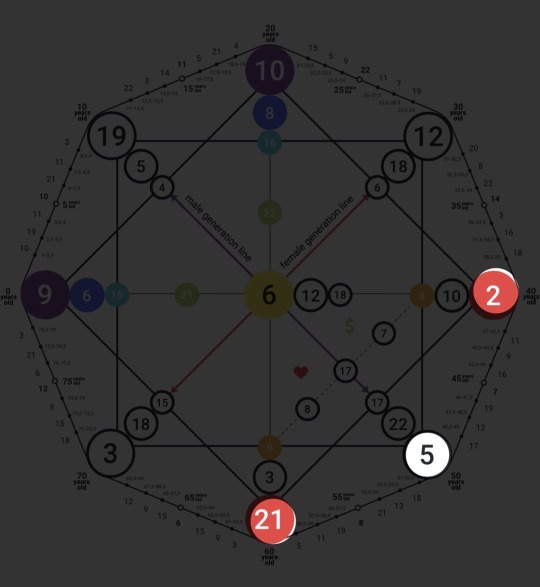
2 (the high priestess): you saw the end coming but likely want nothing to do with long term living in a world without life and only death. you probably are a prepper though.
3 (the empress): it's pretty unlikely you will live - you are too reliant on others providing for you and likely would miss the conveniences of the modern world.
4 (the emperor): 100% is going to live - this person saw it coming and was preparing for a long time (mentally, physically, etc). they don't have interest in a commune either or rather they would never be dependent on others to survive - they would probably become a leader in an apocalypse.
media representation: any lead character in a post-apocalyptic movie / tv show
5 (the hierophant): dooms-dayer - 100% percent would pray on those who are scared and convince them that you have minimal ways to survive most of which will involve aiding them. they are the type to dictate to others what they need to be done but won't get their own hands dirty. they have zero issues turning religion into a way of life and claiming that current passages were warning them all along - they definitely would result to implementing scare tactics.
media representation: david in the last of us
6 (the lovers): reliant on others for survival. they aren't likely to last long in that regard but also they are likely prone to depression and would become existentialistic.
7 (the charioteer): their survival depends on whether or not they have survival gear - if they don't have a good baseline, they are likely going to be the first to go. they do make good nomads though so long as they do not depend on motorways too early into the apocalypse.
8 (strength): they start out strong then end up giving up. they can be prone to getting hurt too so it is likely they will succumb to infection - perhaps consider shaping up your first aid and herbal knowledge base.
9 (the hermit): the hermit himself was a man of the wilderness - he disappeared on his own and survived on his own. these people are likely to do the same. very little will impend them they just have to be of the mindset they can do it.
media representation: the tv show alone
10 (wheel of fortune): this is the person who just survives based off of dumb luck sometimes these people have really really bad luck though.
11 (justice): this is a practical individual - who knows how to use their resources. unfortunately, they are rather high maintenance so they might be unhappy in a post-apocalyptic world.
media representation: american horror stories: apocalypse (s8)
12 (the hanged man): nope 100% wouldn't make it - probably would be the one to want to loot and take from stores then get hurt in the process because they aren't aggressive enough.
13 (death): they bounce back all the time, so i wouldn't be surprised if they just keep coming back from almost dying.
media representation: joel in the last of us
14 (temperance): they would be great at moderation/rationing their supplies, but they can experience exposure to the elements that nearly kills them if not kills them.
15 (the devil): nope, they are too dependent on the modern world and likely couldn't adjust to new horrors of an apocalyptic world.
16 (the tower): i mean they are preppers and i can see them being capable and durable, but they are accident prone and can have a horrible death if not careful.
17 (the star): absolutely not - these people are quick to give up and feel hopeless in a post-apocalyptic world. they are also prone to being overly exposed to the elements.
18 (the moon): i feel like they could survive but the question is whether or not they could bear being alone with themselves... being alone makes you face all the shadows of the self. i don't feel that they would do well in a group dynamic as they would clash with the different personalities.
19 (the sun): oop these people dip so hard. they don't care what it takes to survive they simply will.
20 (judgment): simply yes. they are very capable of remaking a life in a world they no longer recognize.
21 (the world): definitely. this is a bad ass placement - they come out on top every single time. they are often the last man standing in a survival situation.
22 (the fool): they lack awareness and it tends to be their downfall. also they take too many risks and in a survival situation, you can't simply "wing it".
like what you read? leave a tip and state what post it is for! please use my "suggest a post topic" button if you want to see a specific pac/pile next. if you'd like my input on how i read a specific card or what i like to ask my deck, feel free to use the ask button for that as well.
click here for the masterlist
click here for more web of wyrd related posts
want a personal reading? click here to check out my reading options and prices.
© a-d-nox 2024 all rights reserved
#astrology#astro community#astro placements#astro chart#astrology tumblr#tarot witch#tarot art#daily tarot#rider waite tarot#tarot deck#tarot reading#tarot cards#tarot#tarotscope#tarotblr#tarotcommunity#wyrd web#web of wyrd#matrix of destiny#matrix of fate
200 notes
·
View notes
Note
Humbly requesting any HCs you might have for Dammon's reaction to you finding his copy of "A Pleasureable Deal" in his bedroom 👀
[For anyone who needs the background, may I present this delightful post thread]
Oh now THIS. This is very nice to think about. 👀 Somewhere in here there is a fic called Bedtime Stories or something waiting to be written, but here are some initial thoughts instead:
If Dammon walks in on you holding it in your hands, he will wish the floorboards could open up and swallow him
Doesn't even stop to wonder how you got into his room in the first place. He's just consumed by immediate, overwhelming embarrassment
He's blushing the darkest, hottest shade of bronze
Your opinion is the one he values most. So the last thing he wants you to think about him is that he's some kind of depraved pervert (please go off babe I assure you we would all be delighted)
How you react in the next moment would definitely guide the situation
If you took the high route and came at it like you were just fascinated to see this rare banned book, wondered how he found it etc, it would make him able to muster the strength for a short conversation with you
And he would feel eternal gratitude that you've graciously given him an out on this one
If you turned the situation into a come-on (wanna read it together, why read a book when I've been here the whole time, etc.) He would 100% get a shame boner
Would probably immediately want to kiss you so you couldn't tease him anymore
OR. Consider this possibility
Maybe Dammon doesn’t realize that you’ve been in his room and discovered it. But the next time you’re in a one-on-one conversation with him, you just casually drop in part of a stanza or quote. Because you can't resist teasing him and seeing his reaction
You can watch his whole body freeze up for a second. But his mind will be ticking, ticking forward
Did…you just say what he thought you said
Maybe it was a coincidence. He will reject that idea right away though, because he's intimately familiar with the passage you just referenced
Let's be honest he's probably read this thing front to back a hundred times, he could recite his favorite juicy passages from memory
Dammon's a hardworking, lonely, single man and there's not that much mind-blowing smut going around Faerûn these days
It will click right away that there's not many copies of this book to be found, it being banned and all
And the most likely explanation for where you found it is about to give him a heart attack
He'll acknowledge your teasing then, with a nervous chuckle, trying to deflect about how he should've known a locked door wouldn't keep your sticky fingers out
This only leads to him thinking about getting your fingers sticky, which does not help his composure at all
Similar to the previous scenario—your reactions would play a huge part in how the situation unfolds next
If you initiated any kind of flirting around it, he would take things to the nearest bedroom as soon as possible. He’s ready to be done with books for a while
Dammon is down bad for you. You discovering his smut stash isn't the way he was hoping this would start, but nevertheless he's more than ready to get your relationship going
#dammon x reader#bg3 dammon#dammon bg3#very very delicious to think about#bg3 smut#bg3 spoilers#underdark-dreams
440 notes
·
View notes
Text
The Current Timeline of Wild Kratts:
Remember 3 years ago during the hiatus when I made that detailed post explaining the chronological lore of Wild Kratts and analyzed its timeline of a decade's worth of episode with a dash of my own HC involved in it and posted it onto the Wild Kratts fandom subreddit?
Yeah, I promised updates to it when the new episodes arrived, and here I am years later where the season has already premiered. Not to mention there were people who messaged me about legitimate errors I made that I accepted humbly, but didn't actually fix. Not to mention the crossovers that I completely ignored.
Well, much like in 2021, I had wayy too much free time on my hands and decided to go back and finally update that timeline. Unfortunately, Reddit's character limit prevented me from getting the edited version posted so I grit my teeth and decided to bring this fucker to Tumblr via copy and paste. Yeah, I'm not even kidding. So if you've ALSO got enough free time on your hands or are someone who read the original post who was desperately searching for an update, you've got it.
Full post underneath the cut: Warning, shit gets crazy down there.
The PBS Kids original animated show “Wild Kratts” has turned a decade old in the 2020's. Within that time, an autobiography, a 200 episode milestone, and a theatrical film based on the series is confirmed to be in development.
With new episodes of the show coming out, I figured that I’d analyze the show by making an analysis for its timeline. Like many shows, it does have continuity, but Wild Kratts is one of those shows which apparently has an extremely open universe where events happen within that universe, but they don’t seem to have a coherent timeline or any serialization. Many episodes are aired out of order and it’s hard to find a passage of time in a show which doesn’t rely on over-serialization in order to tell its own story.
I partly blame this on production errors as well as strict scheduling as well as the network focusing on releasing episodes in order of when they were produced as opposed to the intended date.
I’ll give it the benefit of the doubt that it doesn’t just rehash its timeline over and over again (unlike some other shows I know cough cough Arthur & Family Guy cough cough). Continuity does exist. It’s just figuring out how it falls in line that is the hard part.
I’ll update this post every time a new episode comes out. My plan is to analyze every single episode until the series finale so that we can determine how much time passes in the show. The way I'll order the timeline is by chronological order first. If there exists an episode or a group of episodes that do not contradict the order, but is not stated to go within this order, I will place them by original air-date and not production order.
I had found a website that lists every Wild Kratts episode (minus the hour-long specials) in order by air-date, unlike the Wild Kratts wiki & Wikipedia. Now, I did find some errors, as it claims that the first 2 episode aired on December 31st and not January 3rd, however I can forgive that as that has been a misconception for years and it got only the date wrong and not the order of episodes. So I was able to use that as a reliable source, more so than the fandom wiki. I am also running off of vivid memory based on my viewing experience as a kid, since I grew up with the show and have come to realize how much info I've retained from the universe of my hyperfixation and how I can use that to this post's advantage. Let's get into it.
Activate Analysis Powers!
--------------------------------------------------------------------------
SEASON 1:
Let’s start with the very first 2 episodes to be released: Mom of a Croc and Whale of a Squid.
In that episode, we see that the Kratt Brothers are already familiar with what’s around them. They’re familiar with the Minaturizer, their Creature Power Suits and Disks, and adventuring with the coolest creatures from oceans to trees (sorry, had to squeeze that reference in).
We see that some animals and inventions are introduced into this episode like the Hippo Sub, Crocodilla, and her daughters. However, let’s focus on things which aren’t introduced in this episode.
Most notably, the Gharial Power Disks and the Miniaturizer. Let’s focus on the disks first.
Near the climax of the episode, the Kratt Brothers use the Gharial Power Disks to substitute for Crocodile Powers since they did not have a disk. Gharials and Nile Crocodiles are both in the order Crocodillia, but were not in the same species nor family. That, along with different designs, makes gharials and crocodiles in general very different animals, which is why the activation didn’t hold up (I hope to god they actually make an episode around gharials in the next season).
Many people assume that this episode only takes place after Kerhonk since Chris uses Gharial Crocodile Power, but this is actually false. Listen closely to what Chris is saying.
“Ha! Crocodile. And a gharial is a type of crocodile!”
Now we’ve already established that a gharial is NOT a crocodile despite being a crocodillian, but let’s get to the important part. Chris is saying that as he pulls out his Crocodile Disk for the Creature Power Suit. Now here is the thing. He doesn’t pull out a Gharial Disk. He uses the Croc Disk to activate Gharial Power, but he doesn’t use a gharial disk to activate the corresponding power suit.
So if Aviva did invent Gharial Power by the events of Kerhonk, Chris would’ve used that instead of using the Crocodile Disk as a substitute. And assuming that episode predates Mom of a Croc, the Kratt Brothers would’ve obviously used the Crocodile Disk since they have used it before.
So that means there was some off-screen adventure where Aviva made Gharial Powers which took place before Kerhonk.
...But that would mean Chris would already have a Gharial Power Disk by the events of Kerhonk and Mom of a Croc. One of 2 things is likely the case. Either Chris didn’t have access to the disk and used Crocodile Power as a last resort (as we see, the disk holder doesn’t exist until Season 2, so he probably stuffs them in his pockets), or that episode exists in an alternate timeline, which we know isn’t the case since that episode’s continuity is brought up later (we will see soon).
So we’ve established that Kerhonk takes place after Mom of a Croc, which takes place after an unseen series of events that predate the series itself as we know it.
Now onto the Miniaturizer. We see it in this episode, but 4 episodes later in Mystery of the Squirmy Wormy, the miniaturizer is invented. That leads me to believe that the episode takes place before Mom of a Croc. However, if you look in the background, you can see that the Walrus Power Suit is in the background with a harness and strap over it. This debunks my original theory of this episode predating the invention of the Creature Power Disks.
With the Walrus Power Suit in mind, it has a harness and strap over it, which brings up the question of why?
My answer would be that the harness and strap was meant for the Walrus Suit after it was damaged in Polar Bears Don’t Dance.
So now we’re at the original pilot episode, the first piece of Wild Kratts media produced by PBS Kids (excluding the Flash games that came out a month prior and were removed 9 years later, *sobs*). Here, the operation of the suits is different. Here, Aviva modified the suits for arctic survival and all it takes is for them to touch the animals with the gloves and then press the button. In many episodes, the modification occurs with the existence of a Creature Power Disc, or the disk is seen off-screen.
But the more I see into it, the more it makes sense. Ever wonder why we don’t see some creature power disks of creature powers in the earlier episodes? Maybe it could be the same reason why we don’t see the Polar Bear and Walrus Disk for the Creature Power Suit.
Aviva pre-programs the Creature Power Suits into the animal that the user can activate into not because she prefers this over making discs, or because the discs are already inserted into the suit, but because this was before she began making Creature Power Discs. This explains why in many Season 1 episodes, we don’t see the disc itself because the power is preprogrammed into the suit.
So at what point does this end and Aviva starts making discs? Any could be. All we know is that this would soon become the norm over preprogramming the power into the suits.
Polar Bears Don’t Dance could possibly chronologically take place around the earliest in the Wild Kratts timeline.
In Mystery of the Weird Looking Walrus, Aviva talks about upgrading features into the Walrus Power Suit. Maybe she isn’t talking about inventing the suits, but modifying the suits, which is fitting considering the walrus suit somehow malfunctioned and got jammed (which was presumably due to the cold arctic ice).
In the same episode, Zach and Donita’s interactions appear to be as if they had met recently, with Donita referring to Zach as the one who “vomitted from clams under the table.” So already we’re forming a coherent timeline with these episodes and we’re not even half-way through Season 1.
There would be one inconsistency. In this episode, Aviva says Jimmy’s controller is waterproof (along with food-proof) but in Seasquatch, 16 episodes later, Jimmy’s controller is protected by a shrink-wrap, indicating that it isn’t safe from the environment. Well, here’s the thing.
That episode shows a second appearance of the Squid Power Suit and Bumper the Sperm Whale from the episode Whale of a Squid which aired alongside Mom of a Croc on the premiere date of the series.
There’s no reason not to believe that the whale episode takes place after Mom of a Croc, which we have already established, takes place long after Polar Bears Don’t Dance. With that, my only explanation is that Jimmy’s controller wasn’t 100% waterproof since salty water can actually be very damaging to technology.
In Octopus WildKratticus Koki lists down many Creature Powers shown. This includes Honey Badgers, Polar Bears, and Octopi. This indeed indicates that these episodes where these powers debut are placed before this episode (some say it’s a retcon, but I disagree since Martin could’ve activated Honey Badger Power after the events of Honey Seekers).
Now let’s address the continuity in the series.
In Season 1, the Kratt Brothers have 2 adventures in the Australian Outback: Ones with kangaroos and koalas. In the koala episode, Chris mentions Aviva inventing Thorny Devil Disks for the Creature Power Suits the last time they were there. Considering that the kangaroo episode was 2 episodes prior to this one, I’m making it count.
Mimic is a sequel to Cheetah Racer, which takes place after Falcon City. In Mimic, the Cheetah Power Disk is invented, which is later used in Caracal Minton.
A Huge Orange Problem takes place after Kerhonk since Schnozzle (I think that is his name appears and Chris and Martin refer to him by that name.) This means that Kerhonk is in the official timeline of WK, meaning the only explanation as to why the Kratt Brothers had little access to either the Gharial and Crocodile Power Disc is that they physically had no access to it due to misorganization.
The Food Chain Game introduces new Creature Powers treated as familiar powers, which indicates that they were already invented off-screen. No episodes introduce these Creature Powers so that means the episode can't be out of order.
In Masked Bandits, Chris and Martin originally intend to use Wolf Power as costumes for their Halloween party, but instead Raccoon Powers are activated and Wolf Power is instead invented in Little Howler.
Ok so let’s go over the established time-line so far. When listing down the time-line, I’ll first do the episodes that chronologically fit together, then I’ll list episodes through air-date if there’s no connection or contradiction between them, then I will go back to chronology if I need to.
Polar Bears Don’t Dance → The Mystery of the Squirmy Wormy → The Mystery of the Weird Looking Walrus→ Unnamed Gharial Crocodile Adventure Episode → Mom of a Croc → Whale of a Squid → Aardvark Town → Flight of the Draco → Platypus Cafe → Bass Class → Build it Beaver → Voyage of the Butterflier XT → Honey Seekers → Fireflies → Tazzy Chris → Octopus Wildkratticus → Walk on the Wetside → Elephant in the Room → Let the Rhinos Roll → Kickin’ it with the Roos → Koala Balloon → The Blue and the Grey → Falcon City → Cheetah Racer → Mimic → Kerhonk → A Huge Orange Problem → Caracal Minton → Zig-Zagged → Seasquatch → The Food Chain Game → Masked Bandits → Little Howler → The Gecko Effect → Flight of the Pollinators → Birds of a Feather → Googly Eye: The Night Guru → Stuck on Sharks → A Bat in the Brownies → Raptor Roundup → Quillbur's Birthday Present
And that’s the end of the S1 timeline
Season 2:
Now already, we can see that Season 2 is a continuation of Season 1. The Tortuga HQ has an upgraded design, most likely from Aviva, which foreshadows the events of “Tortuga Tune Up.”
For the sake of things, I will put Speaking Dolphinese and Blowfish Blowout at the start of the S2 timeline because we don’t see the Tortuga so there’s a high possibility of it retaining its original design from S1 (I’m not including Lost at Sea because that was a terrible special that did nothing but combine 2 unrelated episodes into a movie).
The Seahorse Rodeo takes place afterwards since in Tortuga Tune Up, we see Blimpy (who is now an adult) and Ocean Pony.
Next we have Tortuga Tune Up, which shows Aviva modifying the Tortuga for swimming mode. Obviously I like to think the Tortuga’s redesign was an attempt to fix it, until Aviva had realized something was amiss.
Rocket Jaw: Rescuer of the Reef is a part of the Coral Reef saga of episodes so I count it at the beginning of S2.
Then we have Bad Hair Day, Race for the Hippo Disc, Creature Power Challenge, and Termites Versus Tongues, all of which are the first 4 ep. of S2 and take place in Africa. I consider those 3 chronologically connected. Plus, Zach recalls stealing the Creature Power Disc in one episode.
Happy Turkey Day is a Thanksgiving-related episode but I can easily consider it to be in the timeline.
Bugs or Monkeys serves as the first installment of the Central American Rainforest/Coral Reef saga. Followed by Shadow: The Black Jaguar, Rainforest Stew, Secrets of the Spider's Web, and To Touch a Hummingbird.
Then we get a bunch of episodes taking place in the Sonoran Desert. First we have Rattlesnake Crystal, which introduces the Sonoran Desert. I include this directly after the hummingbird episode because here, Aviva modifies Eyelash Viper Power for Rattlesnake Powers.
In the episode “Roadrunner” Chris and Martin say they have only JUST arrived at the Sonoran Desert. That episode’s plot is focused around the Tortuga getting a resupply, which is fitting considering they just recently crashed.
I would put “Skunked” after Roadrunner since it appears that they have enough resources by now. Then we’d get “Gila Monster Under My House,” then “Desert Elves”
Aqua Frog would come next I assume, I see no reason not to.
Groundhog Wakeup Call and Journey to the Subnivian zone have little ties to other episodes so I can place them in order of air-date. Since Attack of the Tree Eating Aliens takes place in the spring, we can have them come after those episodes.
So the Season 2 timeline goes like this:
Speaking Dolphinese → Blowfish Blowout → Rocket Jaw: Rescuer of the Reef → Seahorse Rodeo → Tortuga Tune Up → Bad Hair Day → Race for the Hippo Disc → Creature Power Challenge → Termites V. Tongues → Neck and Neck → Happy Turkey Day → Bugs or Monkeys → Shadow: The Black Jaguar → Rainforest Stew → Secret of the Spider's Web → To Touch a Hummingbird → Rattlesnake Crystal → Roadrunner → Skunked → Gila Monster Under My House → Desert Elves → Unnamed Burrowing Owl Disc Creation Episode → Aqua Frog → Journey to the Subnivian Zone → Snow Runners! → Groundhog Wakeup Call → Attack of the Tree Eating Aliens
Season 3:
Now, a lot of misconceptions have been made around Season 3 in terms of both continuity and air-date. My stance? Don’t believe a goddamn word that Google, Wikipedia, or the Wild Kratts wiki says. They have been getting the episode air-dates wrong since the very beginning, which is the reason I have to organize them.
As a longtime fan of the show who has been there since the beginning, I pretty much know the air-dates of the episodes by heart and the order.
The first episode is Hermit Crab Shell Exchange, second is Where the Bison Roam, third is Bandito: The Black Footed Ferret, fourth is When Fish Fly, fifth is Osprey. All 7 of these episodes premiered from April 7th to April 11th, 2014 as a part of PBS Kids' Wild Kratts Week, celebrating the show returning for its 3rd season.
The episode to air after that is the double-length episode, Back in Creature Time, which despite popular belief is NOT the Season 3 finale. The last episodes of Season 3 were centered around Madagascar. But before that, we see some adventures in the cypress swamp and the prairie.
Now that we’ve cleared up the misconceptions that people have had about Season 3’s episode order for the past 7 years (yeah a BIG fuck you to Wikipedia for that shit) let’s address the order continuity wise.
The first 7 episodes aired from April 7-11th as part of PBS Kids’ Wild Kratts Week! Celebrating the show’s renewal of S3. All but one would likely remain at their place. All except for Where the Bison Roam and Bandito since it introduces the prairie arc.
Back in Creature Time was after a LONG hiatus. Just to give you a good idea as to how long it was, the first 7 episodes of S3 aired in April when I was still in school, then the Back in Creature Time special aired months later long after I had moved into a different house during summer vacation.
The first episode to air after Back in Creature Time was Mosquito Dragon and Crocogator Contest (they were aired together as part of a special called “Swamp Things” but that special sucked for the same reasons why Lost at Sea did).
Now, this is something I noticed. Mosquito Bots were already invented by the time of Back in Creature Time, meaning that episode takes place after Mosquito Dragon.
And if we’re to include the cypress swamp saga, that means that Back in Creature Time comes in around the middle of the S3 timeline chronologically. That’s not even including the prairie episodes.
There were also Madagascar episodes. I consider Lemur Legs is chronologically the first of the order since the Kratts enter Madagascar here, and the finale of this arc is Golden Bamboo Lemur, where they leave.
This will be hard to crack, but I might be able to do it.
A thing that I noticed was that the Dragonfly Power Suits got redesigns frequently in S3. In Osprey and Mosquito Dragon, it has basket legs, resembling its S1 counterpart, but in Florida Panther and Back in Creature Time, they look completely different. In-universe, this can be credited to Aviva redesigning the suit, so I tried to arrange the episodes in a way that would make the suit's metamorphosis (pun not intended) feel less jarring than if you were watching the episodes in production order or viewing order.
So the S3 timeline is
Hermit Crab Shell Exchange → When Fish Fly → Osprey → Crocogator Contest → Mosquito Dragon → The Search for the Florida Panther → Opossum in My Pocket → Slider: The Otter → Back in Creature Time → Where the Bison Roam → Bandito: The Black Footed Ferret → The Amazing Creature Race → Prairie Who → Mystery on the Prarie → Under Frozen Pond → Capture the Fishmobiles → Praying Mantis → Lemur Legs → Chameleons on Target → Aye-Aye → Lemur Stink Fight → Tenrec Treasure Hunt → Fossa Palooza → Mini Madagascar → Golden Bamboo Lemur
Season 4:
Once again, this season was distributed out of order and the years that have passed since its release, however, as someone who, once again, watched every episode the day they aired, I can correct the misconceptions.
Firstly, the first episode of S4 was The Last Largest Lobster, and the last episode was Musk Ox Mania. The 3rd episode was A Creature Christmas, followed by 5 additional episodes, one of which introduced Paisley Paver and Rex into the show.
Now the confusion is that A Creatire Christmas aired as the 3rd episode of S4, yet animals and Creature Powers in that episode wouldn’t be introduced until later. So I’ll list down all of the episodes that come before the Christmas special.
The Last Largest Lobster comes before Stars of the Tide (they literally aired back-to-back).
Panda Power Up comes first in the China-located episodes. Next up comes Golden Snub Nosed Monkey Man. Red Panda Rescue features both Giant Panda and Snub Nosed Monkey Power, so I imagine it comes next. At the end of that episode, Aviva alludes to Red Panda Power, which is present in “The Colors of China”
Pangolin Rescue follows that (remember, all of these take place before A Creature Christmas). Along with the Two-Tusked Narwhal Adventure, the Snowy Owl Invasion, the Puffin adventure, the Other Martins, and This Orca Likes Sharks.
At this point, we’ve covered all of the pre-Christmas episodes. Now let’s do the ones we have left.
Liturgusa Krattorum, Eel-lectric!, Sea Otter Swim, Box Turtled In!, Animals Who Live to be 100 years old, Archerfish School, and many others.
Something to note is that Aviva narrates how the villains have never before teamed-up. Ignoring the fact that it is not true, that episode would have to come before Krattorum.
Here’s the timeline of S4:
The Last Largest Lobster → Stars of the Tides → Box Turtled In → The Other Martins → Sea Otter Swim → Animals who Live to be 100 Years Old → Spirit Bear → Panda Power Up → Snowy Owl Invasion → Golden Snub Nosed Monkey Man → Red Panda Rescue → The Colors of China → Pangolin Rescue → Archerfish School → Baby Tooth & Kid Musky → Musk Ox Mania → Puffin Rescue→ Mystery of the Two Horned Narwhal → This Orca Likes Sharks → A Creature Christmas → Cheetah Adopted → Eel-lectric → Liturgusa Krattorum → Creatures of the Deep Sea
Season 5:
I’m gonna throw in my personal opinion… This is my least favorite season of the show. The premiere episode, Alaska: Hero’s Journey was pretty cool and in my opinion, jumped the shark for Wild Kratts as we know it. Not only did it establish continuity with previous adventures and use it as a key-factor for the episode’s story, but it introduced a Creature Power Suit for Koki and had a very mature theme and an awesome message.
And then it went downhill from there. A lot of episodes, whilst enjoyable, felt pretty weak. Some were forgettable, and it felt like it talked down to its audience more, and there were just a lot of things that I felt didn’t work. This is where I think the show began a heavy seasonal rot and I know I'm not alone in this.
Ok, opinions aside, the time-line of this season is a lot easier to decipher than the earlier ones because there were less episodes.
Even though Alaska: Hero’s Journey was the first episode of S5 to be aired, the Bald Eagle Power Suit was shown, yet it wouldn’t be invented until The Fourth Bald Eagle.
Many listings show Mystery of the North Pole Penguins as the S5 premiere. And given that there are no continuity errors in that episode, I can see it being the start of Season 5’s storyline.
In the next episode, Temple of the Tigers, Martin and Chris head to India to adventure with tigers. A majority of S5 takes place in India, including the episode where Paisley Paver and Rex return, so I view the tiger episode as the start of the “India” arc.
There are also several episodes centered in Europe, as part of what I like to call, the “Europe” arc.
Creepy Creatures would go near the end of this timeline, as we see many S5 Creature Powers and animals by then.
So here’s the timeline for S5
Mystery of the North Pole Penguins? → Temple of the Tigers → The Dhole Duplicator → The Cobra King → Sloth Bear Suction → Elephant Brains → Cheeks the Hamster → Fire Salamander → Komodo Dragon → Wild Ponies ---> City Hoppers! → Blue Heron → Choose your Swordfish → The Erminator → Hercules: The Giant Beetle → Creepy Creatures! → The Fourth Bald Eagle → Alaska: Hero’s Journey
Season 6:
This season in my opinion, was a slight step up from the 5th season, since we get to see more interesting animals, and the writing feels a lot more breathable. The color palette, I specifically would go without, because it just looks weird. What I do like is how they recasted Koki, a character of color, to be voiced by a woman of color, and I'm glad this change is permanent.
Instantly, we get an instance of a continuity error: Martin is shown to have a Jackrabbit Power Disc in the 2nd episode of S6, yet he doesn’t get it until the Easter special, In Search of the Easter Bunny. There’s actually a reason behind this. The original title for the episode focusing on bunnies was titled “Spring Bunnies” and was listed as the Season 6 premiere, however this was cut and the bunny episode was released almost a year later. My working theory is that because of tight schedules, “Spots in the Desert” was released before the introduction of the Jackrabbit Power Disc.
We return to the Amazon once again with the double-length episode, Amazin’ Amazon Adventure and we get some newer amazon episodes after that.
In a promotional video for Hero’s Journey, the Kratt Brothers said that Season 5 would have at least 23 episodes. My guess is that they had to cut down the last 5 episodes because of COVID or something.
There are two things that stand out the most to me in this season's timeline. For starters, in the Hammerheads episodes, we see that the brothers have an Antelope Disc for the Creature Power Suit despite there being no episode centered around those creatures or introducing a Power Disc. Much like the Burrowing Owl and Gharial Discs, we're to assume that there was an adventure focusing around that animal/an invention of that Creature Power Disc that was not televised, and thus is part of this season's lineup.
The second was how in one of the first episodes of Season 7, Chris expresses a desire to adventure with wolverines, despite that happening in the previous season. So in a rare case, this has to go in a different season's timeline to remain consistent.
Anyways, let’s go onto the timeline of the most recent season. I’ll be going off of habitat here just to be consistent.
In Search of the Easter Bunny → Mystery of the Flamingo’s Pink → Spots in the Desert → Wolf Hawks → Deer Buckaroo → Unnamed Antelope Adventure Episode → Hammerheads → The Vanishing Stingray → The Real Ant Farm → Mystery of the Mini Monkey Models → Amazin’ Amazon Adventure → The Great Froggyback Ride → Parrot Power → The Race to Goat Mountain → Iron Wolverine → Adapto the Coyote → Tartigrade Xtreme → Uh Oh-Ostrich! → The Great Creature Tail Fail → Cats and Dogs →
Season 7:
The long-awaited Season 7 has arrived as of 2023, marking the return of the show to PBS Kids after two years of a hiatus. With eight episodes having been released, 13 more confirmed on the way, and the 200th episode milestone airing in S7, fans have a lot to hope for. And thankfully it means new fodder for my timeline list.
As I've said before, The Race to Goat Mountain cannot be a part of Season 7's timeline since it has to take place before their actual wolverine adventure.
This in of itself is purely subjective but I like to imagine that Clever the Raven would be the first episode of S7. For a few reasons. One, it was the first episode of the season to be confirmed (in an interview with Jane Goodall). Secondly, compared to Outfoxed, it felt more like a season premiere. With the fanservice-callbacks, the villains returning, the simple-structure of the plot with no rising or falling action and the episode's overall writing, it basically marks off a check-list of everything in the show that you were missing out on for 2 years and everything that you're coming back to after such a long break. Plus it's my favorite out of all of the S7 premiere episodes. Call me biased, but this one's going first.
Our Blue and Green World was the first of the episode batch in 2024. Personally, I am putting it as the most recent spot in the S7 timeline, after the other 3 episodes. The reason being is because with Paisley Paver's redemption, this episode feels like a huge game-changer, one that the writers hint will affect the rest of the series. I think this special should've been the last to air in the batch just to get viewers hyped for what's next. It's basically like a mid-season finale of some sorts:
Three new episodes will air in November of 2024: Salamander Streaming, Bumblezzz, and Chimpanzee and Me. Until the episodes come out, I will list them in the timeline in their release date order.
Timeline of Season 7:
Clever the Raven → Outfoxed → Owl Odyssey → No Name Dream → Backpack the Camel → Fish Out of Water → Our Blue and Green World → Salamander Streaming → Bumblezzz → Chimpanzee and Me
CROSSOVERS:
There are three shows that Wild Kratts has crossed over with. One of which came out after I made this post, two of which before, but I decided to add them here just for the fun of it and to commit to the lore-dump of the timeline. Whether or not I'll extrapolate that into forming a huge novel about the expanded universe of PBS Kids, only time will tell.
Night Shift: (Odd Squad)
This was the first crossover the brothers had done with another show, Odd Squad, a live action math-based cartoon that is set to air its fourth season in 2024. The Kratt Brothers have their traditional live-action opening that is interrupted by Otis and Olympia solving their 'odd problem' a running gag with various different characters throughout the series as a 'cold opener.' The reason there is such a massive overlap between the two fandoms is because of that scene in the episode.
How to fit it into the canon? Well, since this is shot similarly to a Wild Kratts live action opener segment, then we can equate it with the "what if!?" element of the show. It should be noted that the Kratts are following a white-tail-deer, an animal they would later adventure with in Season 6. So you could have this episode take place directly before the "what-if?!" section of that episode that transitions into the animated story.
Wild Batts: (Nature Cat)
In 2015, PBS Kids launched a new nature based show known as "Nature Cat" featuring the titular cat and his gang of animals exploring nature. This special aired directly after Wild Kratts: A Creature Christmas, so PBS Kids often marketed both the WK Christmas special and the Nature Cat premiere, so much so that at the end of the Christmas episode, the Kratt Brothers themselves promoted the new Nature Cat special. It only made sense that these nature brothers from another mother teamed up! And thus we had Wild Batts! In this episode, Chris and Martin "Batt" have to find a new home, after their old one is destroyed, challening Nature Cat and Ronald's fear of bats in the process and learning more all about them. Several references to the Kratt's show are made, such as the classic "Living free and in the wild!"
How to fit it into the canon? In the episode's context they are literally bats, but in the context of the show itself, they would probably be in Creature Power Suits. And one thing interesting is that Chris and Martin are said to be Indiana bats, an endangered species of North American bats. We know that there is no singular Creature Power Suit for a generalized species as we've seen with the crocodillian, owl, and snake-based Power Suits. So it's possible that Aviva modified the Little Brown Bat/Vampire Bat programing with Indiana Bat Power. So this would probably take place post-Season 1. I have it take place in Season 6 since Wild Batts aired around the same time that Season 6 just started airing, ironic ain't it?
Oh, and the episode also makes bat references to other PBS Kids characters, such as Peg + Bat (Peg + Cat), George the Curious Bat (Curious George) Daniel Bat (Daniel Tiger's Neighborhood) and the Bat/Cat in the Hat. Now, the logical man within me says that these are easy puns to laugh at and not look into. However, the sick twisted fuck that is me says, connect that shit together. Since we've already established Odd Squad, we can probably say that there was an 'odd problem' turning these random PBS Kids characters into bats (probably including the Kratt Brothers if you don't buy the idea that they're in very convincing Creature Power Suits) and that the Odd Squad is able to save them with a reverse-bat-inator and they all go their separate ways, never to meet each other again until their grand return in PBS: Endgame (ok maybe I'm going too far into it but just a funny thought, also yes that is the one MCU reference I decided to cash in).
Cry Wolf: Molly of Denali
The 3rd of the Wild Kratts crossovers, airing in summer of 2022. This was a massive thing in the WK fandom, mainly because around that time, news had come out that the show would not air any new episodes until 2023, which was a massive low blow. This crossover between Wild Kratts and Molly of Denali, while not enough... at least damaged this blow and is an okay entry point to Molly of Denali, another pretty damn good PBS Kids show.
The Kratt Brothers help Molly and her dad track a missing pack of endangered wolves, learning more about them on the way. In the episode it's established that Molly is a huge fan of Wild Kratts, referencing their show a lot, implying that the Kratts we see here are 2D representations of their IRL selves rather than their 2D-in-universe selves. Still, I came here to overanalyze, and overanalyze I shall! Since the Kratts did their whole "what-if!?" skit in Odd Squad, then I could see the same happening here, just not being necessary for the episode's plot. I'll suspend my disbelief again because what the hell.
How to fit it into the canon? I'd have it come between Season 6 and 7. It aired around that time, and again, it was almost certainly done so as compensation for making fans wait 2 years for the new season to drop. Plus it lines up with my headcanon of Clever the Raven being the first in S7's timeline, since the brothers would still be in the mood to adventure with wolves.
So to conclude, all of these crossovers I see as very recent in the show, you could cut them out and lose nothing, but add them in and get more of something, which is what I'm doing. In terms of timeline to the crossovers specifically, here it goes.
Wild Batts → Night-Shift → Cry Wolf
------------------------------------------------------------------------------
CONCLUSION: THE CURRENT TIMELINE OF WILD KRATTS
Polar Bears Don’t Dance → The Mystery of the Squirmy Wormy → The Mystery of the Weird Looking Walrus→ Unnamed Gharial Crocodile Adventure Episode → Mom of a Croc → Whale of a Squid → Aardvark Town → Flight of the Draco → Platypus Cafe → Bass Class → Build it Beaver → Voyage of the Butterflier XT → Honey Seekers → Fireflies → Tazzy Chris → Octopus Wildkratticus → Walk on the Wetside → Elephant in the Room → Let the Rhinos Roll → Kickin’ it with the Roos → Koala Balloon → The Blue and the Grey → Falcon City → Cheetah Racer → Mimic → Kerhonk → A Huge Orange Problem → Caracal Minton → Zig-Zagged → Seasquatch → The Food Chain Game → Masked Bandits → Little Howler → The Gecko Effect → Flight of the Pollinators → Birds of a Feather → Googly Eye: The Night Guru → Stuck on Sharks → A Bat in the Brownies → Raptor Roundup → Quillbur's Birthday Present → Speaking Dolphinese → Blowfish Blowout → Rocket Jaw: Rescuer of the Reef → Seahorse Rodeo → Tortuga Tune Up → Bad Hair Day → Race for the Hippo Disc → Creature Power Challenge → Termites V. Tongues → Neck and Neck → Happy Turkey Day → Bugs or Monkeys → Shadow: The Black Jaguar → Rainforest Stew → Secret of the Spider's Web → To Touch a Hummingbird → Rattlesnake Crystal → Roadrunner → Skunked → Gila Monster Under My House → Desert Elves → Unnamed Burrowing Owl Disc Creation Episode → Aqua Frog → Journey to the Subnivian Zone → Snow Runners! → Groundhog Wakeup Call → Attack of the Tree Eating Aliens → Hermit Crab Shell Exchange → When Fish Fly → Osprey → Crocogator Contest → Mosquito Dragon → The Search for the Florida Panther → Opossum in My Pocket → Slider: The Otter → Back in Creature Time → Where the Bison Roam → Bandito: The Black Footed Ferret → The Amazing Creature Race → Prairie Who → Mystery on the Prarie → Under Frozen Pond → Capture the Fishmobiles → Praying Mantis → Lemur Legs → Chameleons on Target → Aye-Aye → Lemur Stink Fight → Tenrec Treasure Hunt → Fossa Palooza → Mini Madagascar → Golden Bamboo Lemur → The Last Largest Lobster → Stars of the Tides → Box Turtled In → The Other Martins → Sea Otter Swim → Animals who Live to be 100 Years Old → Spirit Bear → Panda Power Up → Snowy Owl Invasion → Golden Snub Nosed Monkey Man → Red Panda Rescue → The Colors of China → Pangolin Rescue → Archerfish School → Baby Tooth & Kid Musky → Musk Ox Mania → Puffin Rescue→ Mystery of the Two Horned Narwhal → This Orca Likes Sharks → A Creature Christmas → Cheetah Adopted → Eel-lectric → Liturgusa Krattorum → Creatures of the Deep Sea → Mystery of the North Pole Penguins? → Temple of the Tigers → The Dhole Duplicator → The Cobra King → Sloth Bear Suction → Elephant Brains → Cheeks the Hamster → Fire Salamadner → Komodo Dragon → Wild Ponies -> City Hoppers! → Blue Heron → Choose your Swordfish → The Erminator → Hercules: The Giant Beetle → Creepy Creatures! → The Fourth Bald Eagle → Alaska: Hero’s Journey → In Search of the Easter Bunny → Mystery of the Flamingo’s Pink → Wild Batts → Spots in the Desert → Wolf Hawks → Night-Shift → Deer Buckaroo → Unnamed Antelope Adventure Episode → Hammerheads → The Vanishing Stingray → The Real Ant Farm → Mystery of the Mini Monkey Models → Amazin’ Amazon Adventure → The Great Froggyback Ride → Parrot Power → The Race to Goat Mountain → Iron Wolverine → Adapto the Coyote → Tartigrade Xtreme → Uh Oh-Ostrich! → The Great Creature Tail Fail → Cats and Dogs → Cry Wolf → Clever the Raven → Outfoxed → Owl Odyssey → No Name Dream → Backpack the Camel → Fish Out of Water → Our Blue and Green World → Salamander Streaming → Bumblezz → Chimpanzee and Me
------------------------------------------------------------------------------
And there you have it so far folks. Thirteen years, seven seasons, 160 televised episodes, plus four crossover episodes amounting to 164 canon episodes in the current Wild Kratts timeline. More are on their way and more of this grand Creature Adventure is beyond the horizon. Keep on Creature Adventuring, see ya on the Creature Trail!
Am I a genius, or am I a genius?
#wild kratts#timeline#wild kratts timeline#2024#chris kratt#martin kratt#kratt brothers#pbs kids go#pbs kids#2d animation#animation#odd squad#odd squad pbs kids#nature cat#nature cat pbs kids#molly of denali#the cat in the hat#curious george#daniel tiger's neighborhood#aviva corcovado#wild kratts koki#jimmy z#zach varmitech#donita donata#gaston gourmand#animals#crossover#media analysis#wk season 7#reddit
196 notes
·
View notes
Text
i'd like to see more of the theme of "family" in overwatch. we see it a lot with ana & fareeha, ram & zen, brig/torb/rein/bastion, genji & hanzo. but those are the obvious ones between playable characters. the ones that are much more clearly written on the wall, even once-in-a-blue-moon players could pick up on. much else is hardly focused on despite how much family (or a lack thereof) has shaped many of the character's lives & identities for better or for worse
i don't like how martina & the unnamed reyes kid are only mentioned in passing, despite gabriel himself visiting often unannounced. clearly they were an important part of his life. clearly, family is an important part of his life — i'm very willing to wager that small passage about the death of his parents in declassified was written very intentionally. his complicated relationship with death, and how it was further affected by his own "death," & how he's now in some warped reversed position with his new family. but we don't get much more than a few voice lines about martina (is she even mentioned by name in-game orrr am i not remembering?)
i want to see how ashe manages the gang throughout the second omnic crisis. or perhaps we could see her mannerisms slightly change with bob. maybe instead of standing side-by-side with him as she is in the reunion cinematic, she puts herself more between him & potential unrealised threats. or maybe she subtly tries to nudge him under awnings whenever she spots ufos, weary they're housing subjugators — little things that are very intentional. maybe her demeanor tilts ever so slightly from confident but guarded, to guarded but confident.
i want to get a better picture of the role sam english played in fareeha's life just from playing the game, especially after ana's presumed death. i want to know more about their relationship other than the christmas dinner they had. i wonder how many players just assume fareeha's father died young, or assume the writers didn't care to write one at all? for a long time, i thought the former. i wonder what sam thinks of some of fareeha's closest friends — has he met cole & angela? what does he think of helix? we hardly even see fareeha's native heritage expressed other than the two skins off the top of my head
what about cassidy & echo? i know this is a more implied one, but cassidy was the first one to nurture her "childlike intelligence." even today, he guides her — he encouraged her to help winston&co at paris when he was still on the fence. one of the cutest things for me is her enthusiastically shouting "hello winston!" mid-battle, presumably not long after cassidy told her to say hi. she probably would've either way, but i also don't want to discredit the role cassidy has had on her development & i really do want to see more of them
or, speak of the devil, how winston views everyone at overwatch as family. how in watchpoint: gibraltar's 1st defense spawn, you can see the little beds he set up for lena and mei, how you can read an email as proof he got the blankets from a small kids blanket business. the way he keeps photos of the gang, years later. how vehemently protective he was of all their locations. i wish we could see it reciprocated a little more, i wish we could see individual sleeping areas for other heroes as the story progresses, or more items on his desk. & that's not even getting into hammond
& i don't think i can have a family post without mentioning dad 76 or how i desperately want to see benicio being the best supportive dad for lúcio more but honestly i'm getting pretty sleepy so either i'll add more later or someone can add more.
depending how you stretch the definition of family here, it can include other dynamics too. baptiste finding a new sense of belonging in the new overwatch, or mei braving the antarctic to not let her team's death go in vain & to help people who can still be helped — from jiayi and her team still on mars, to the people who now need her help on earth. i'd also argue hana's squad in korea. what are niran's siblings up to? are we gonna see more of efi & orisa? moreover, how are all these non-playable side character characters handling the invasion? i guess we got some texts between lena and emily
family is such a powerful motivator, but can also be really complicated, as seen with the amaris and shimadas + kiriko, i wish we got a similar amount of investment some other places too
a major theme of overwatch is moving towards the future, progressing in some way. & that looks different for everyone depending on their emotional readiness to do that, and what they view "progression" as. so it makes sense a lot of characters don't look back on those they lost along the way so much, at least not too openly (zarya comes to mind), but that's what can make their present relationships with others that much more worth preserving & seeing
probably an impossible ask of a game feeling the effects of layoffs that's primarily focused on pvp/bp/shop items but ykn
thank u for coming to my tedtalk
#i'm writing this on a limb so maybe some lore-related info is off idk#prolly a long-winded way of saying i really want more relationships fleshed out & i want to feel i'm personally getting to know the#characters better too. i was so thrilled when i realised you could read character journals#overwatch#overwatch 2#ow2#lore#analysis#gabriel reyes#reaper overwatch#elizabeth caledonia ashe#ashe overwatch#pharah#fareeha amari#ana amari#ana overwatch#cole cassidy#angela ziegler#mercy overwatch#echo overwatch#winston overwatch#tracer#lena oxton#mei ling zhou#mei overwatch#soldier 76#lúcio#jean baptiste augustin#dva#pve
69 notes
·
View notes